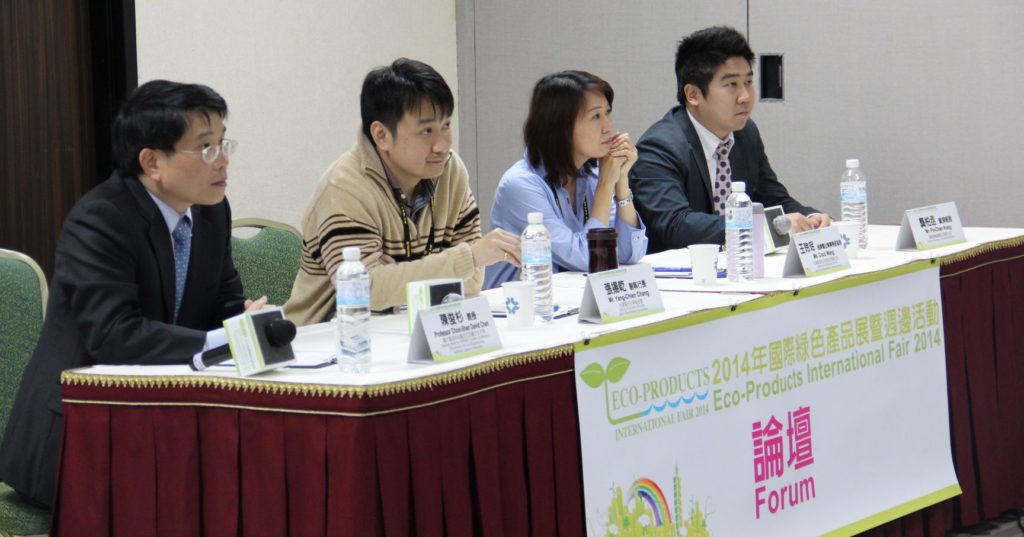Full Report: ECCT LCI participates in 2014 Eco-Products International Fair
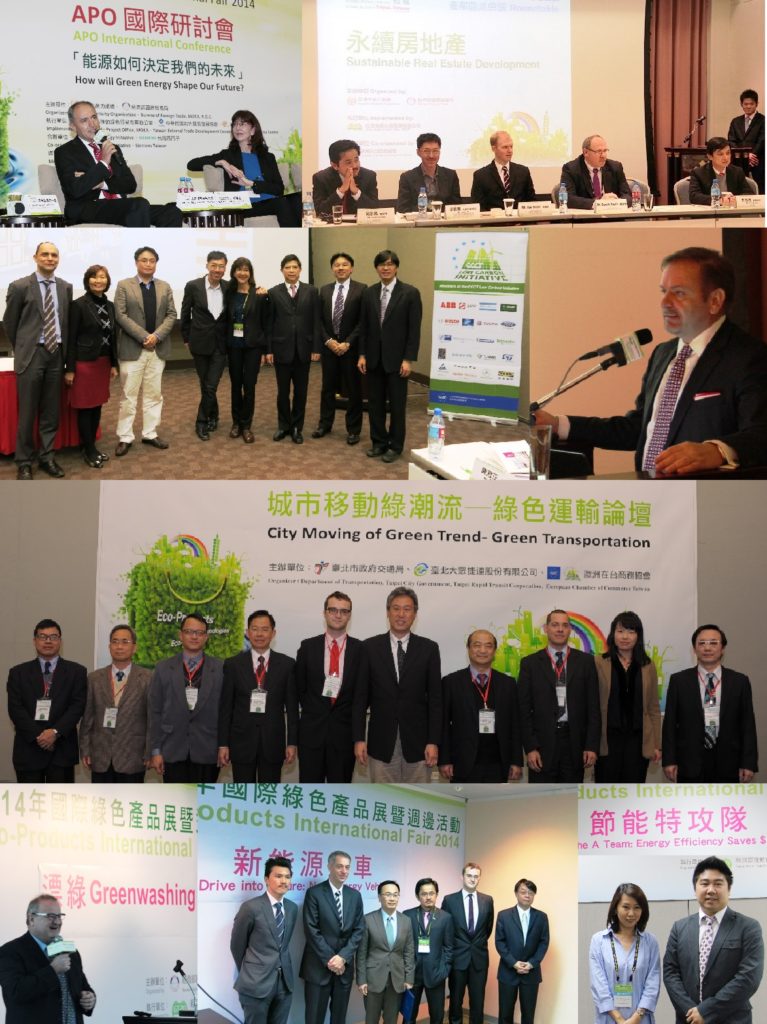
LCI events in 2014 EPIF (view photos by clicking each event):
- APO International Conference: How green energy will shape our future
- Sustainable Real Estate Development Roundtable
- Smarter 2020: Sustainable ICT solutions forum
- Show Me the Green Money: Green Market and Financing forum
- Sustainable Transport Systems forum
- Greenwashing forum
- Drive into the future – New energy vehicles forum
- The A Team: Energy Efficiency Saves $ forum
The Global View Monthly's (遠見雜誌) eight-page report can be downloaded HERE. The BCC (中廣新聞網) program Mr. Big also introduced the ECCT LCI's participation in EPIF 2014 (online radio program). For bilingual event guide please click HERE.
Detail report is as follows:
Thursday, 13 March 2014
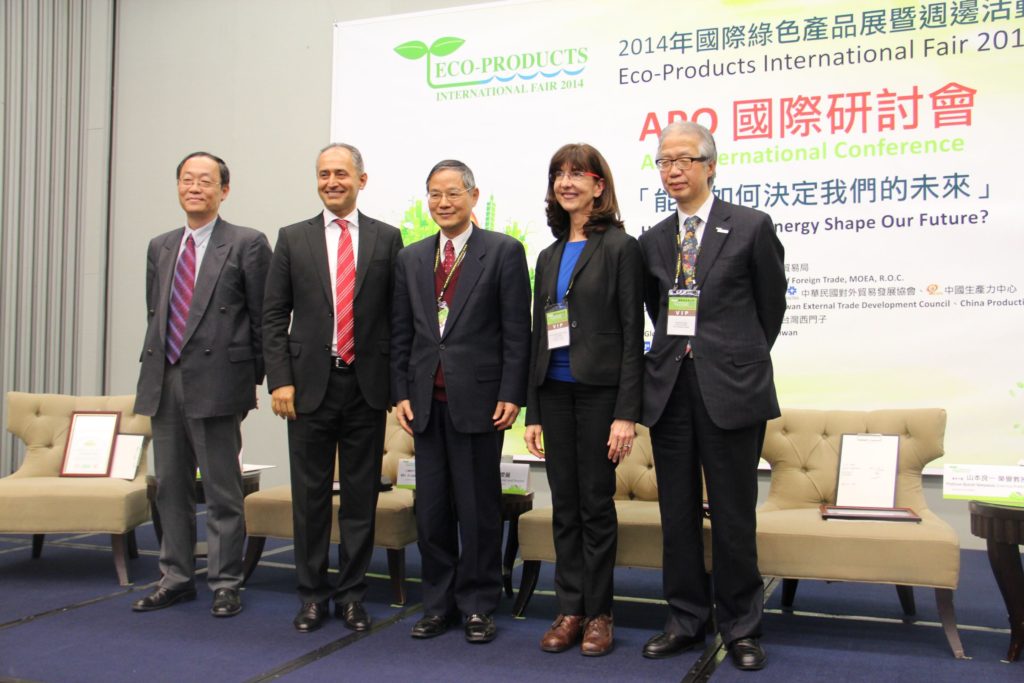
Speaker: Erdal Elver, President & CEO, Siemens Limited Taiwan
The megatrends urbanization, demographic change, climate change and globalization are shaping our future. With the need to improve the quality of life, the environment and economic competitiveness, we have to become more resource-efficient and environmentally-friendly. As an integrated technology company, Siemens offers a wide range of solutions to meet the growing demand for energy of today and tomorrow. The company has the broadest environmental portfolio in the world which covers the entire energy chain. This presentation outllined some of Siemens' answers – in the fields of green manufacturing, clean energy, green buildings, green hospitals, green mobility, and smart grids – to shape a sustainable future.
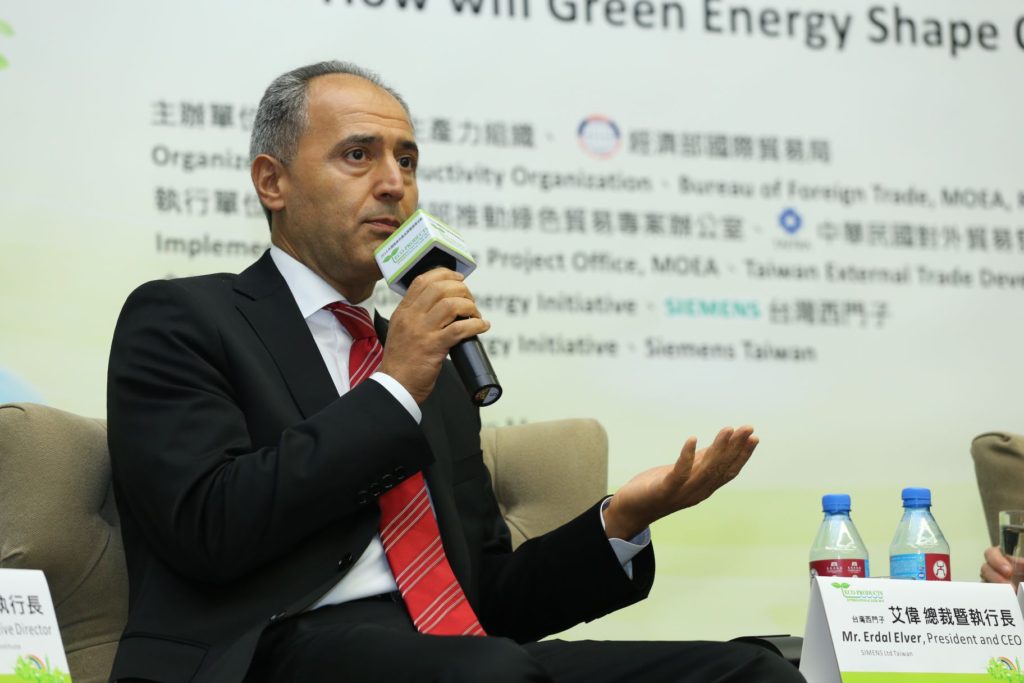
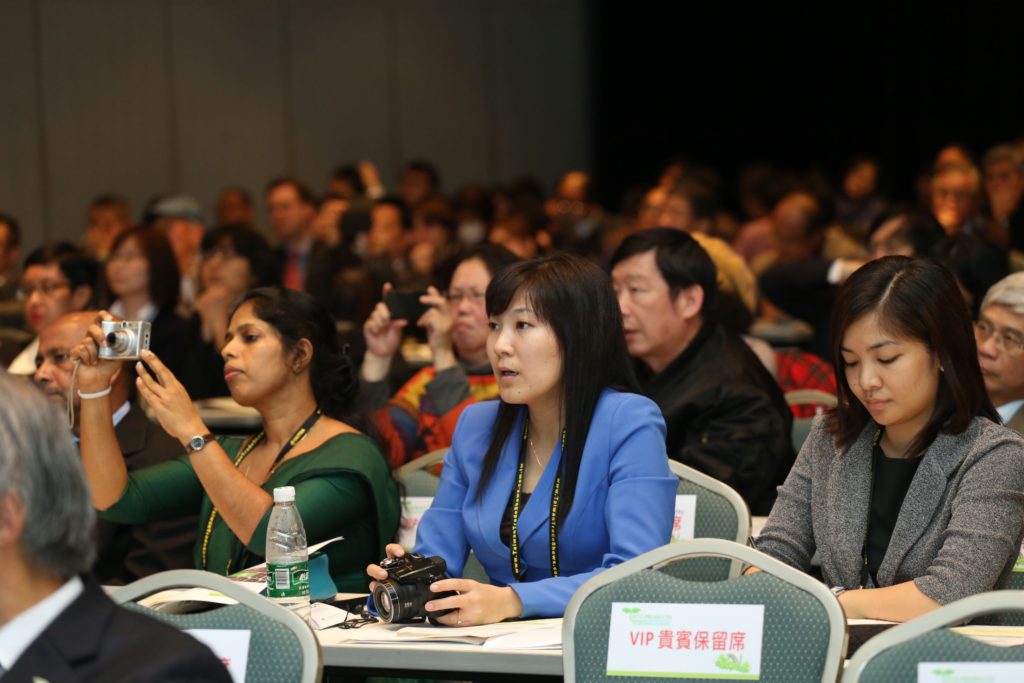
Sustainable Real Estate Development Roundtable
Moderator: Josh Yu, North America Marketing Director, Green Trade Project Office, Ministry of Economic Affairs
The roundtable featured industry experts, including three speakers from the LCI and a panel discussion exploring how sustainability can have an impact on investment and value. Besides the LCI speakers mentioned below the event also featured a presentation by Jay Black, Director of Sustainability for SL Green Realty Corporation.

Speaker: Dereck D Devlin, General Manager, Atlas Copco Taiwan Limited
Atlas Copco is committed to sustainable productivity. The company's motto is to "make performance stand the test of time". Reducing carbon in industry often comes with a high price tag because it is usually costly to take action but, in the case of compressors, this is not the case, according to Devlin. Many people don't actually have a clear understanding of how much carbon is released in everyday life. Driving a car 7,000-8,000 km produces about one tonne of carbon. Using coal to generate 1.2 megawatts (MW) of electricity creates one tonne of carbon while the same amount of carbon is generated when creating 2.3 MW of electricity with natural gas. Flying 13,000 kilometres in a Boeing 747-400 commercial aircraft generates 1 tonne of carbon per passenger while a more modern Airbus A321 generates 1 tonne of carbon per passenger for every 21,700 kilometres.
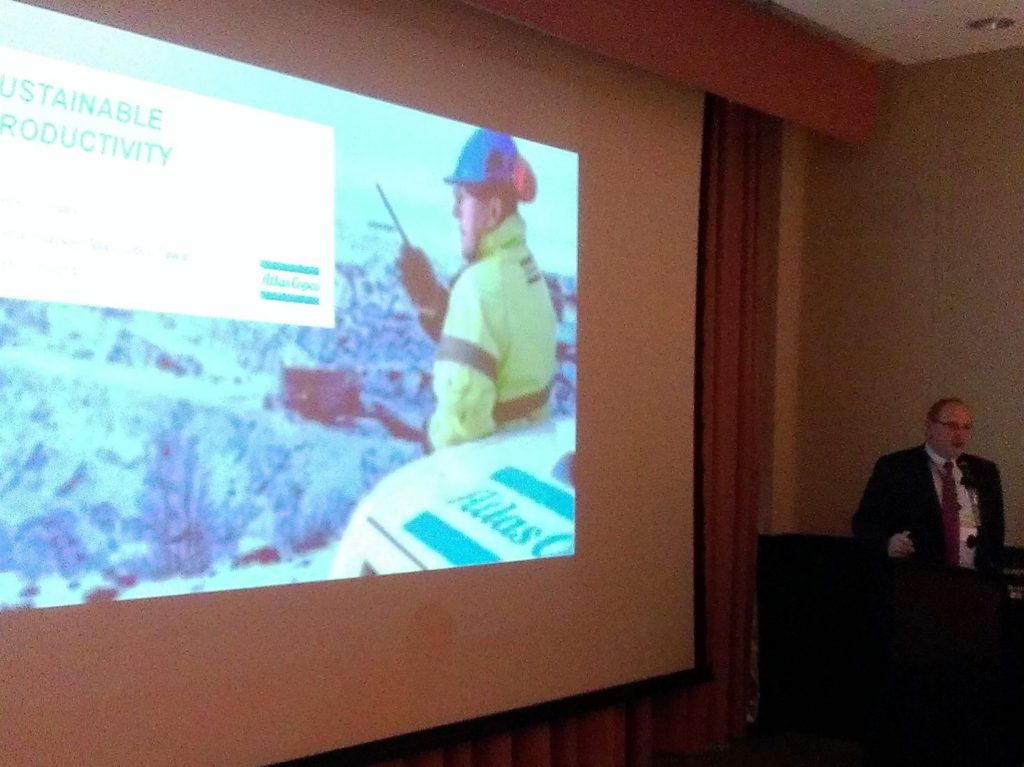
Compressed air is required for a lot of applications and it is very expensive. Taking into consideration the efficiency and running costs of air compressors, it is possible to reduce energy costs and consumption by up to 35%.
One of Atlas Copco's customers requires 145 MW hours of electricity just for air compressors. This creates approximately 750,000 to one million tonnes of carbon per year (depending on the power generation), a fairly large amount considering that Taiwan produces a total of 258 million tonnes of carbon a year.
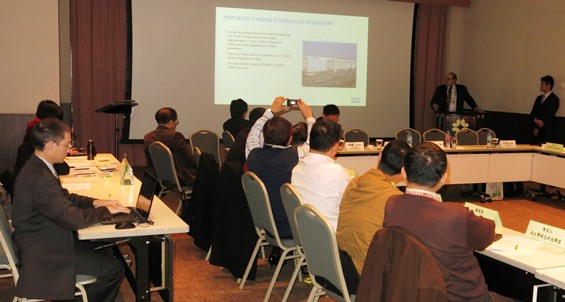
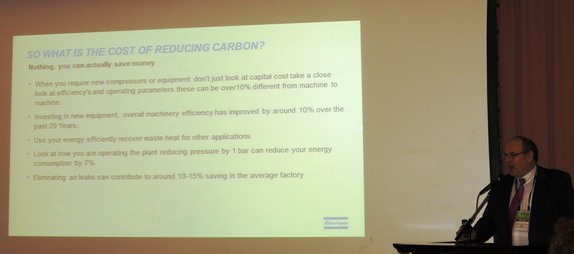
Taking the example of his customer, Devlin said that just a 1% reduction in energy could result in a cut of 7,500-10,000 tonnes of carbon, or the equivalent of taking 5,000 cars off the road for a year. Installing variable speed drive compressors can reduce energy consumption and carbon emissions by up to 35% and the company is now working on a new compressor that can increase this saving by up to 50%. Besides purchasing the best and most efficient equipment, you should ensure that you maintain your machines to the manufacturers' recommendation. Failure to maintain equipment properly can cost an additional 5% in energy costs. Devlin concluded that great solutions are available now and it is much better to install the best equipment at the outset to reduce emissions rather than purchase carbon offsets.
Topic: Chemistry for a sustainable future
Speaker: Englong Goh, Managing Director, BASF Taiwan
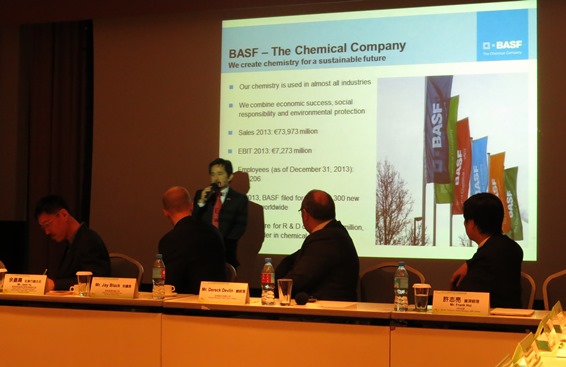
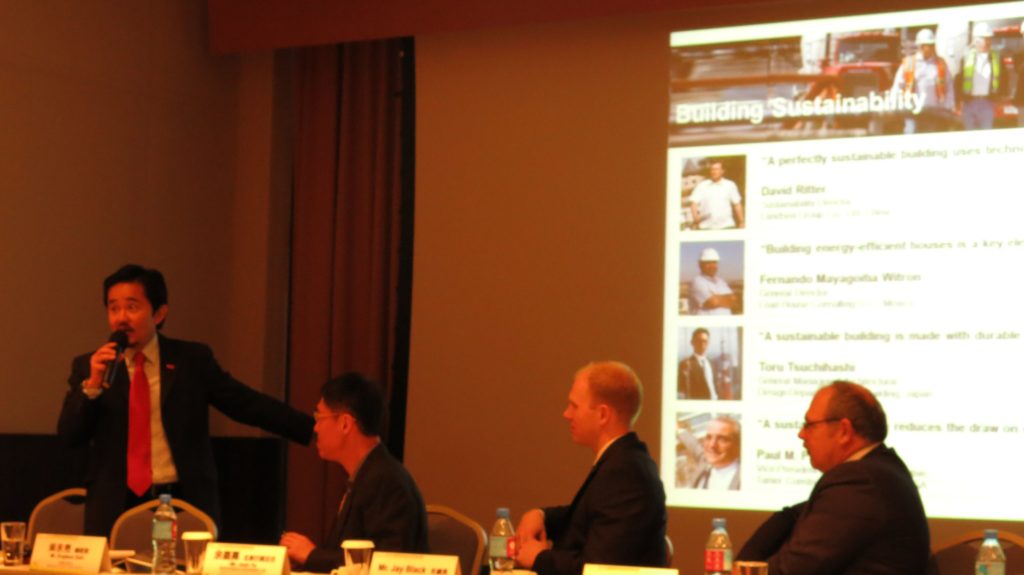
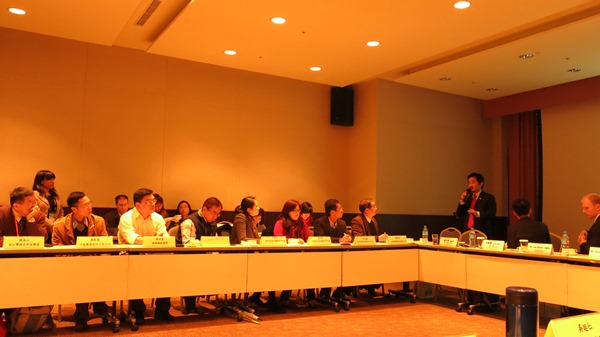
Taiwan is already very innovative and efficient in certain industrial processes but the same rigour is not applied to building design, energy conservation and reducing waste. There are multiple kinds of sustainable materials available for buildings such as insulation for walls and roofs (poorly insulated roofs are a major factor in a building's energy consumption). With the right wall and roof insulation, glass and other materials in place, it is possible to cut air-conditioning usage by 80%. While it is better to design and construct buildings using the best materials and methods, it is not necessary to always start from scratch. Old buildings can be renovated to improve their insulation and energy consumption.
Topic: Renewable energy solutions
Speaker: Frank Hui, Senior Technical Sales Manager, ABB Taiwan
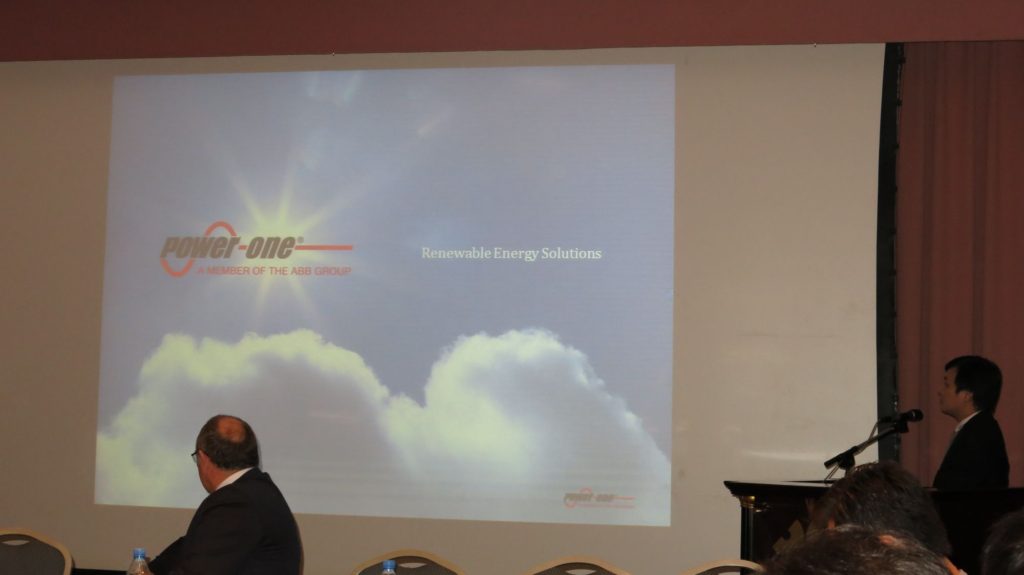
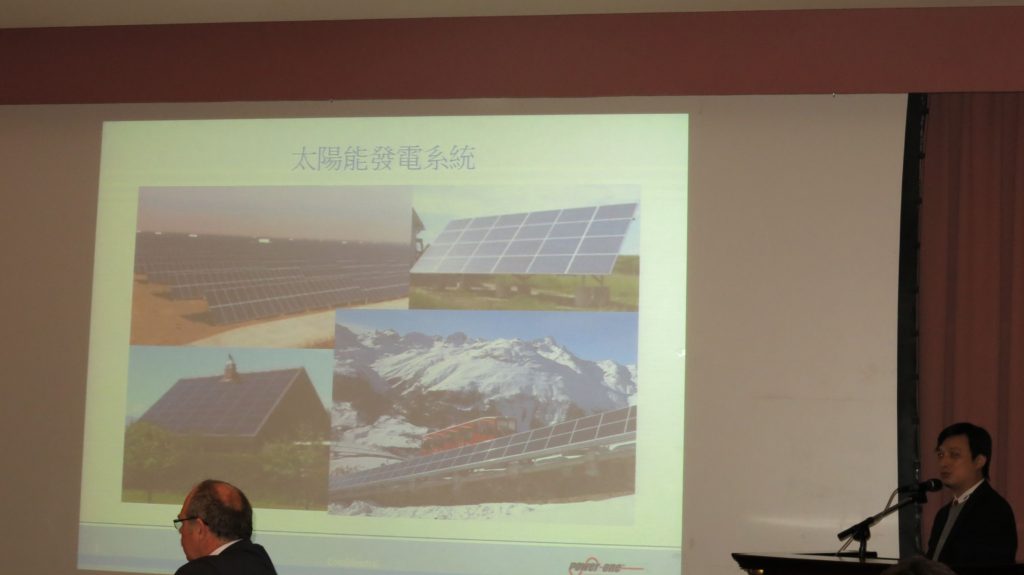
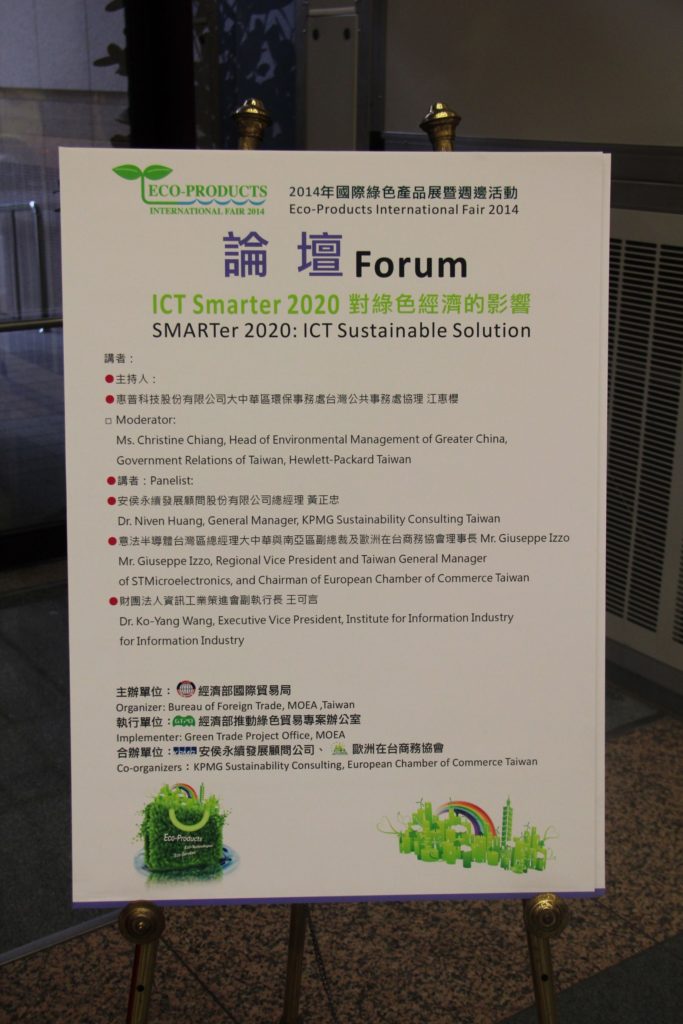
The global e-Sustainability Initiative's (GeSI) SMARTer 2020 report demonstrates how the increased use of information and communication technology (ICT) such as video conferencing and smart building management could cut the projected 2020 global greenhouse gas (GHG) emissions by 16.5%, amounting to US$1.9 trillion in gross energy and fuel savings and a reduction of 9.1 gigatonnes of carbon dioxide equivalent (GtCO2e) greenhouse gases. The report evaluates GHG abatement potential from ICT-enabled solutions ranging across six sectors of the economy: power, transportation, manufacturing, consumer and service, agriculture, and buildings. Emission reductions come from virtualisation initiatives such as cloud computing and video conferencing, and also, through efficiency gains such as optimisation of variable-speed motors in manufacturing, smart livestock management to reduce methane emissions, and 32 other ICT-enabled solutions identified in the study. Besides LCI member STMicroelectronics, the forum featured presentations by Dr Niven Huang, General Manager of KPMG Sustainability Consulting Taiwan and Dr Wang Ko-yang, Executive Vice President of the Institute for Information Industry.
Topic: Smart semiconductor solutions
Speaker: Giuseppe Izzo, General Manager and Vice President, STMicroelectronics
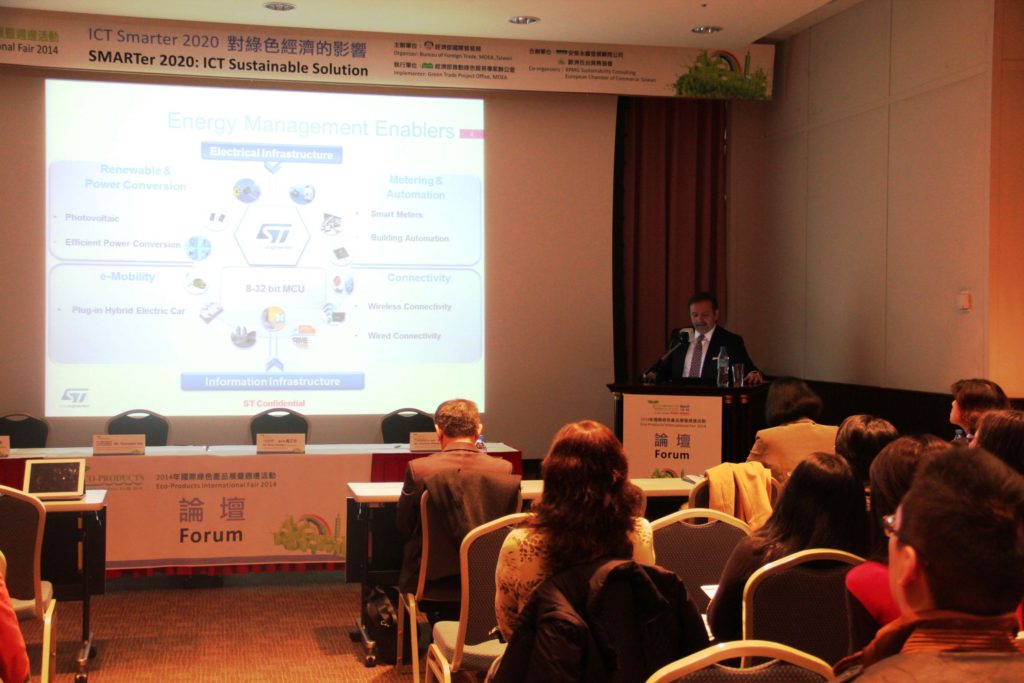
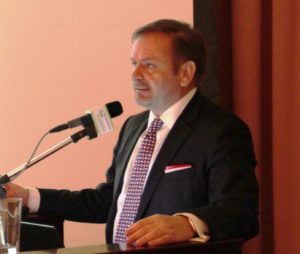
STMicroelectronics provides key technologies to build smart grids which optimize energy consumption, make the entire electricity distribution system more flexible, reliable, and increases the use of renewable energy sources on a large scale. Semiconductors are a key component of the energy revolution which is just beginning.
The homes we live in today can be described as "Feature Homes" but the homes of the future will be "Smart Homes". A modern living room is equipped with a big screen TV or overhead projector, stereo system, comfortable sofa, decorative lighting, thermostat and air-conditioning control but these features are not integrated. To create a smart home, we need to integrate technology and services through home networking for a better quality of living.
ST started smart metering 15 years ago. In Italy and Spain every home has a smart meter and Taiwan is starting. This is important because the future of power generation will be from many sources. Every household has to use this energy efficiency such as using power when it is cheaper. These building blocks help users to use power at the optimal time and most efficiently.
Smart metering puts intelligence into power.
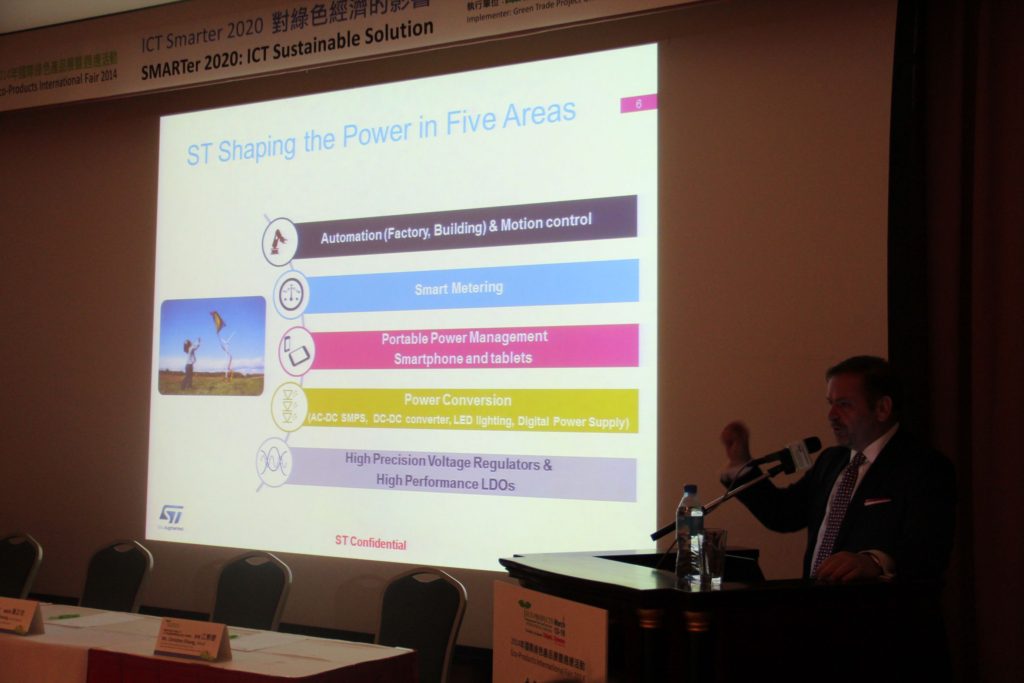
The technical enablers for smart homes are smart devices which are in turn enabled by smart sensors and smart controllers. Smart sensors detect the environment and provide information to smart controllers to make a decision on what action to take. This is where ST comes in. ST brings the advanced semiconductor technology to the sensor component, making it smaller, more energy-efficient and integrating with advanced controllers for intelligent decision-making and connecting to other devices and the external world.
There remain many challenges to overcome: heat, battery power, local storage, privacy and security, among others but progress in material science, battery power, augmented reality and chip evolution is ongoing. Izzo then went on to describe some of his company's products in detail. He concluded by noting that we live in a world where electronics are becoming more pervasive. In every instance where electronics is making a positive difference to people's lives, there is STMicroelectronics. ST develops innovative solutions covering sense and power technologies for embedded-processing solutions that systematically focus on increasing the quality of life, enhancing the intensity of its experience and building on the potential for social improvement. The smart home is a building block of a smart city, helping to make our lives more comfortable while minimizing the impact on the planet. The integration of technology and services through connected smart devices are enabled by smart sensors and smart controllers inside smart homes. Together, this leads to a smarter life.
Show Me the Green Money: Green Market and Financing forum
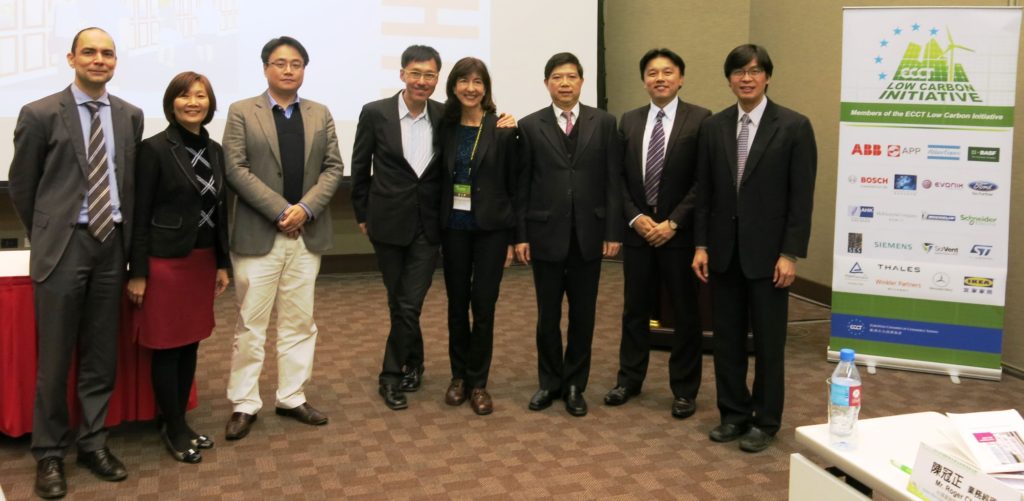
The forum focused on lucrative opportunities in sustainability-related industries, how to create an innovative business model and to overcome the challenge of green finance. Besides the three LCI speakers below, the event featured presentations by Barbara Finamore, President of the China-US Energy Efficiency Alliance and Morris Lin from the Department of Sports, Taipei City Government, who spoke about Taipei City's preparation for the 2017 University Games. The event was attended by a number of companies engaged in the production of green products and providing green services, academics engaged in sustainability research and representatives from European governments.
Topic: Plug into wind energy now
Speaker: Bart Linssen, Service Manager, Solvent GmbH Taiwan Branch
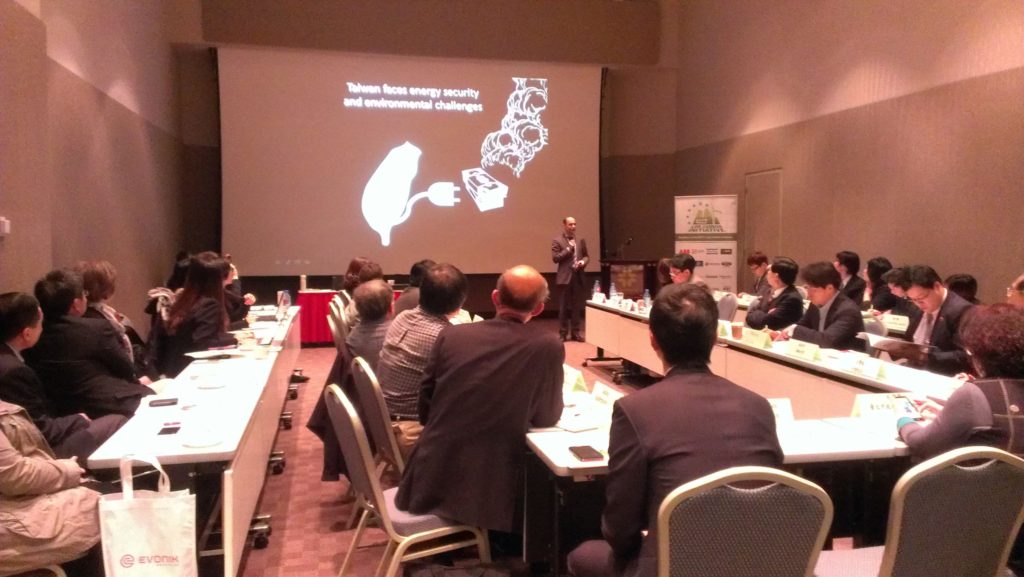
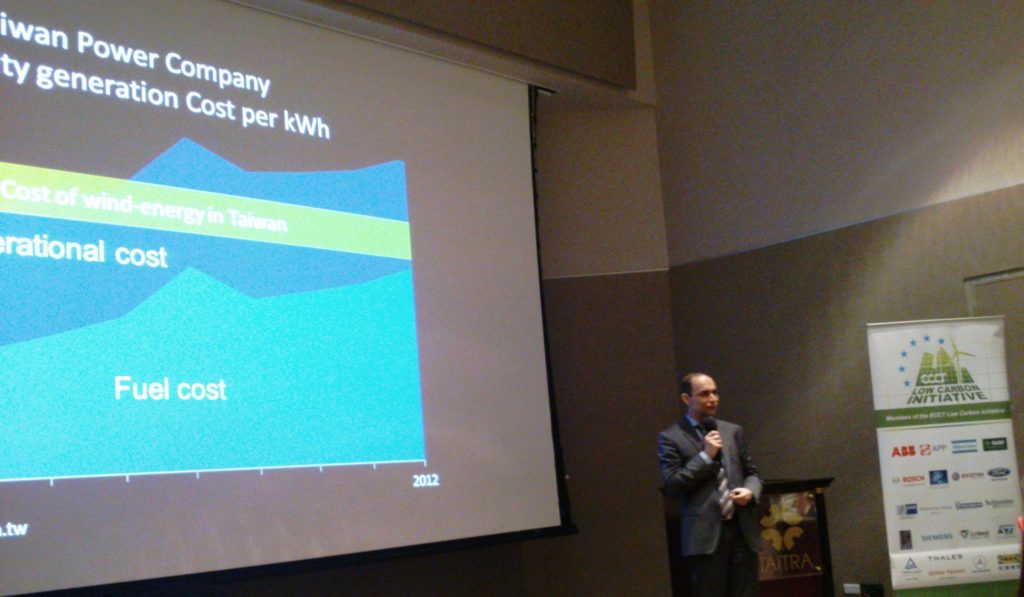
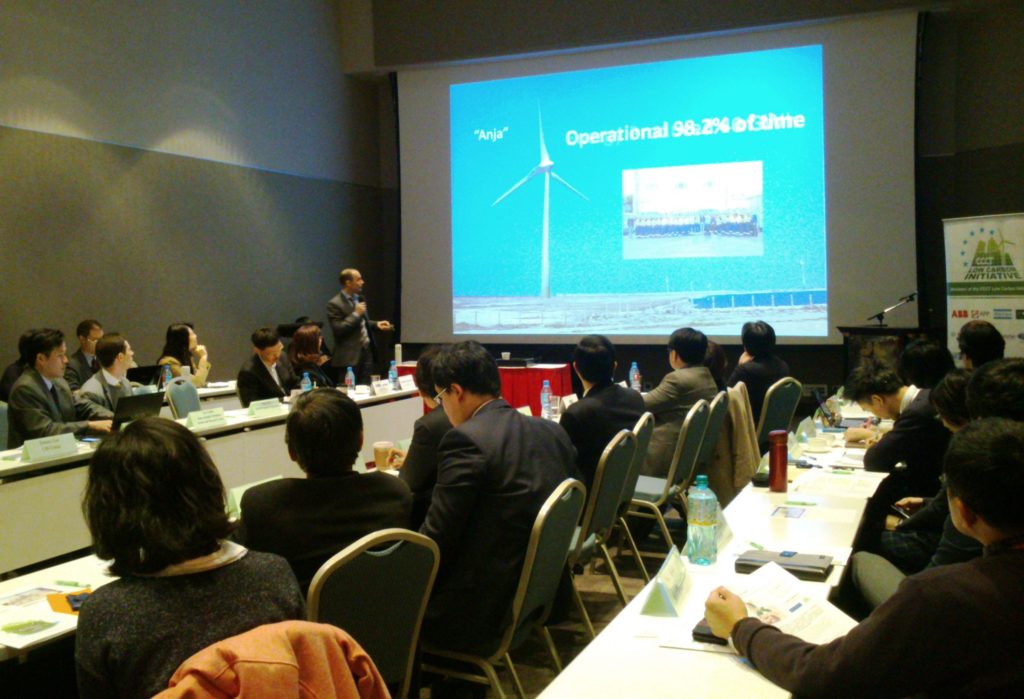
Solvent has 180 wind turbines installed and takes care of their maintenance in Taiwan is burning money, has environmental and energy challenges but renewables are a viable alternative. There is now a great opportunity to get a return on investment and do the right thing at the same time. Onshore wind is now competitive compared to fossil fuel. The cost of wind generated by fossil fuels is about NT$3.04 per kilowatt hour (kwh) but private wind providers are being reimbursed at between NT$2 and NT$2.6 per kwh currently. Even at this low rate, efficient wind energy providers are able to make a small profit and as fixed costs continue to fall, profitability will rise. Moreover, electricity costs from traditional power plants are likely to keep rising. The other major advantage of wind power is that it will increase Taiwan's energy security given that Taiwan still relies on fossil fuels and nuclear energy to meet 98% of its energy needs, all of which need to be imported. In addition, many companies, under pressure from consumers, are demanding lower energy intensity. Taiwan is one of the world's worst performers in terms of energy intensity and consumers are demanding improvement. Green energy is becoming a competitive requirement. Most countries have renewable energy targets but what is less well known is that many companies are taking direct action. For example, IKEA owns its wind turbines and companies like Lego aim to get 100% of energy from renewables by 2020. Companies that can demonstrate that they are using renewable energy to reduce their carbon footprints will increasingly gain a competitive advantage in the market. In conclusion, wind energy makes sense because Taiwan is a perfect location, it is economically competitive and it will improve Taiwan's energy security.
Topic: Show me the green money
Speaker: Roger Cheng, Sales Manager, Coating & Additives, Evonik
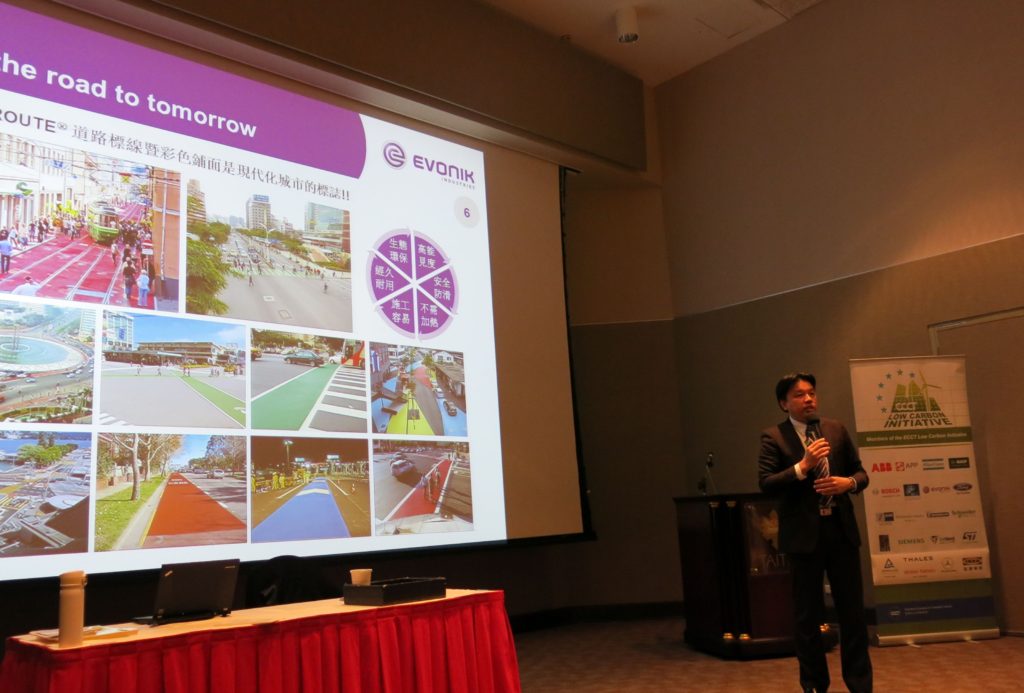
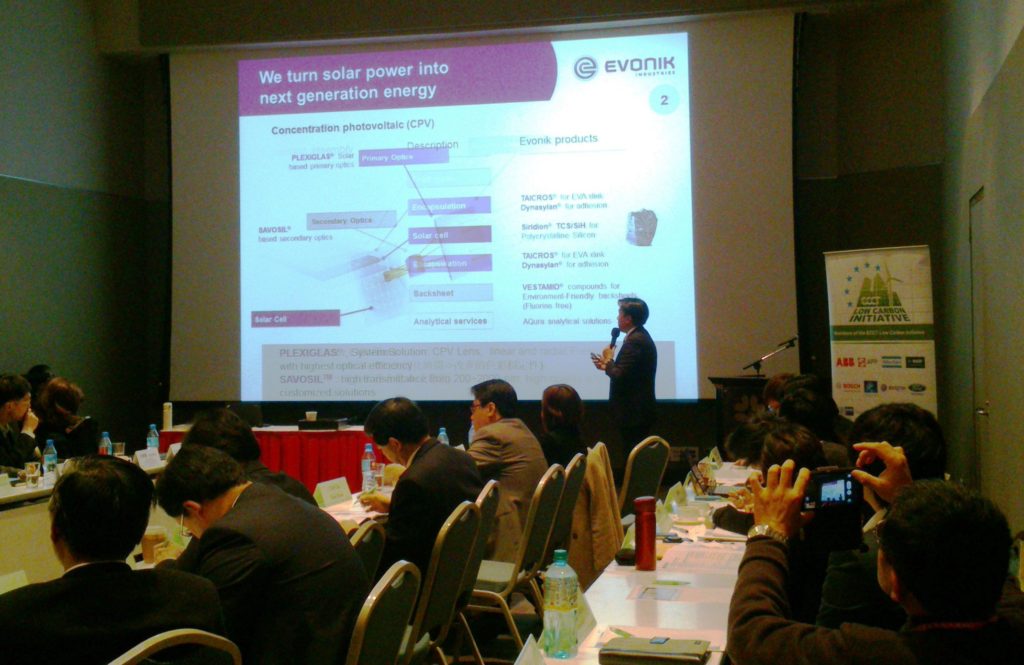
The company is also involved with Mercedes Benz in developing green lithium batteries for electric cars. In the field of solar energy, the company is involved in developing the next generation of solar products that are more efficient. Evonik is also involved in indoor agriculture and building protection by providing coating for exteriors such as marble consolidation and water repellency and easy to clean surfaces.
Topic: Show me the green money
Speaker: Veronica Lin, Director, Energy Management Services, Schneider Electric Taiwan
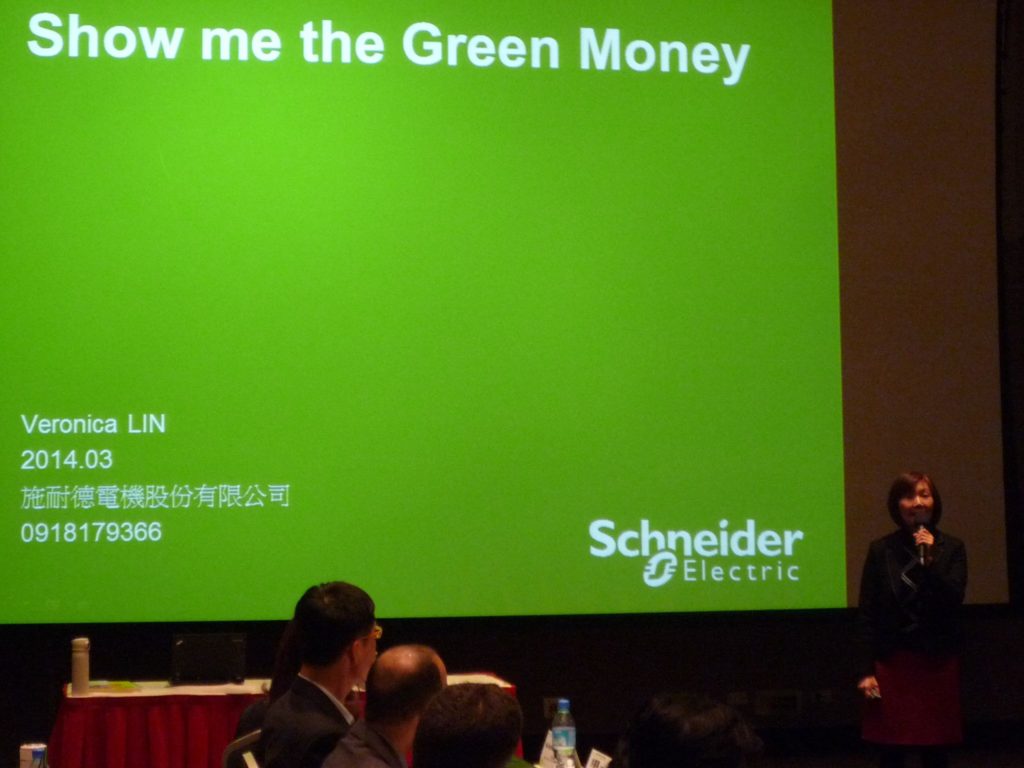
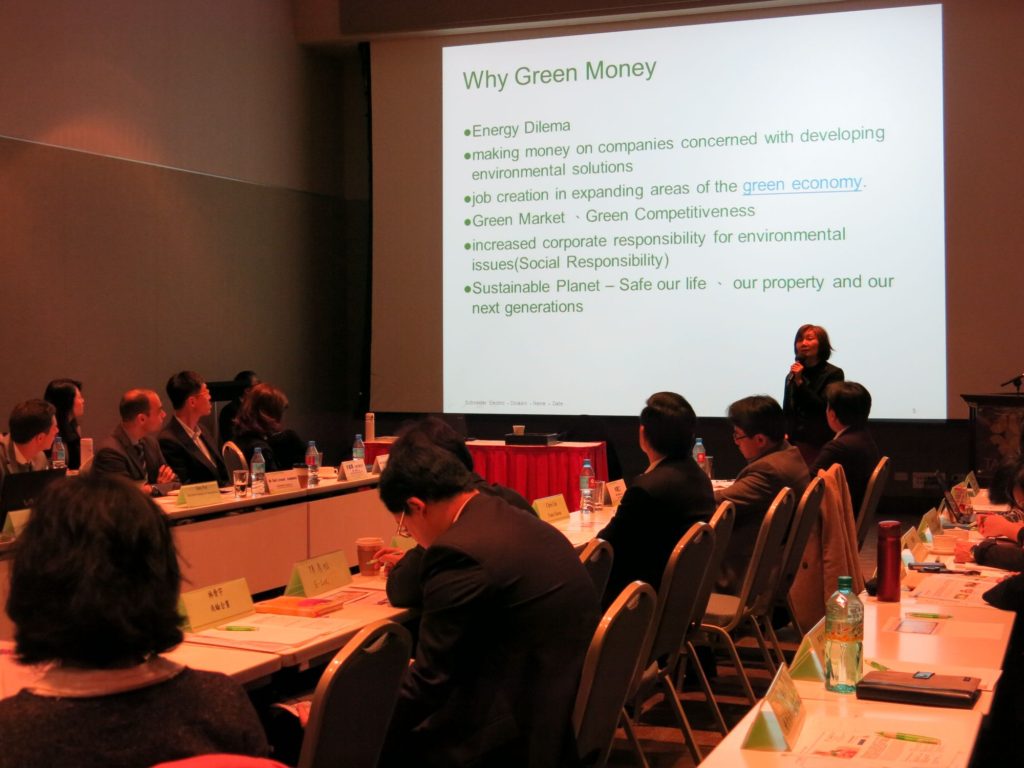
Sustainable Transport Systems forum
Organised by the Department of Transportation, Taipei City Government and co-organised by the Taipei Rapid Transit Corporation and the ECCT
Moderator: YJ Sun, President, Intelligent Transportation Society of Taiwan
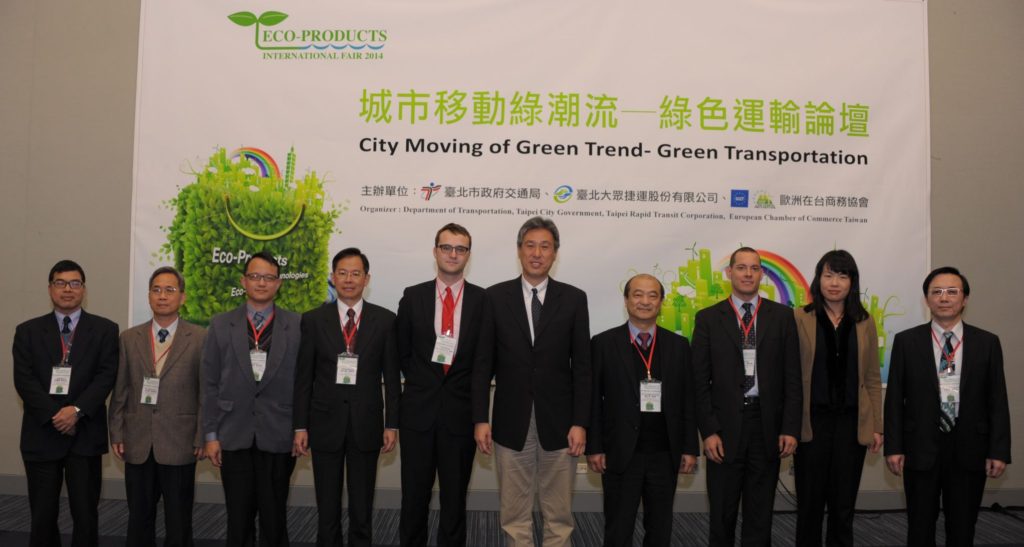
Topic: Public transport in Taipei
Speaker: Wang Shang-Wei, Director, Department of Transportation, Taipei City Government
Wang gave an update on Taiwan's traffic and vehicle situation. The expansion of the MRT has increased the sustainability of transportation in Taipei city. Traffic on the MRT overtook that of buses in 2012 and in 2013 there were an average of 1.74 million daily MRT trips versus 1.61 million daily trips by bus conducted by 14 bus companies on 306 routes. Public transport service is now available within 500 metres of 97.5% of Taipei residents. The city's aim is to encourage the use of public transport or bicycle to increase usage even further to reduce the use of cars and motorcycles.
Improvements made in recent years are dedicated bus lines, disabled access, improved bus shelters and ebus system for real-time bus location and expected arrival time. The smartphone app "Fun Travel" in Taiwan provides information on all types of public transport, taxis, parking lots, bicycles and news.
The TCG provides an open platform for real time transport information to help app developers
There are currently 48 apps, 14 websites and TV stations while the city maintains inquiry lines.
The YouBike system has been an outstanding success after an initial period of trial and error.
The network is now being expanded. Registration is simple and the first 30 minutes are free.
Today, more than 50,000 Youbike trips are taken per day up from 5,000 in 2011 and 2012. There are now 112 km of riverside bike lanes for leisure biking. The city is also working to improve the environment or pedestrians.
Topic: German policy on green transportation: Efficient traffic control system
Speaker: Mirko Kruppa, Deputy Director-General, German Institute Taipei
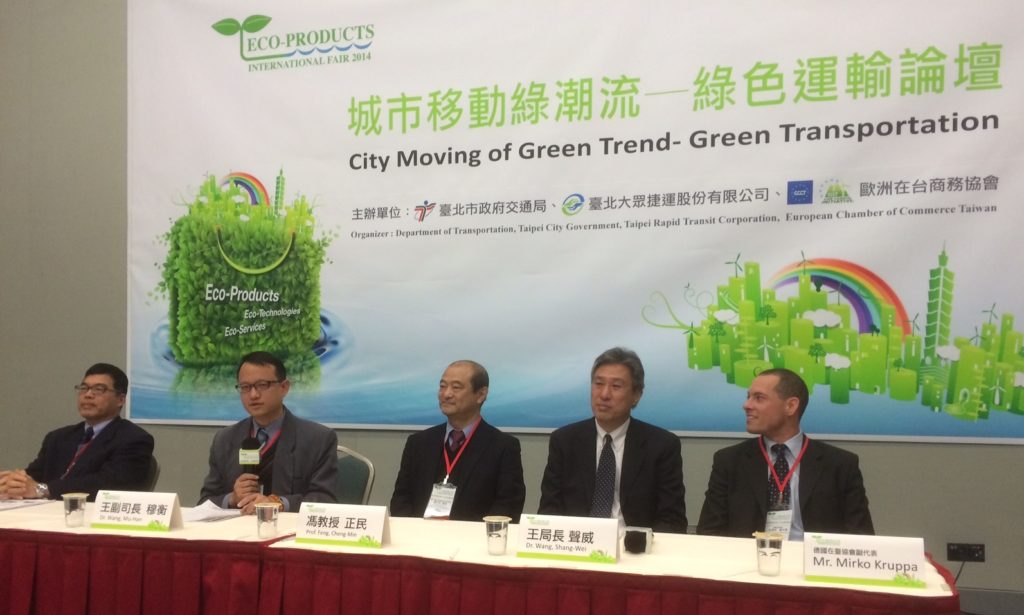
Germany is a federation so there is room for diversified regional policies. While there is competition between cities, there is also cooperation. German cities have full ownership of energy production. There are great opportunities to reduce costs, energy usage and carbon emissions. The future is smart buildings, efficient mobility, smart power grids and decentralized, sustainable and independent energy supply. Germany has set ambitious targets for renewable energy, energy efficiency and electric cars. It is also putting in place a number of smart technologies to improve traffic flow such as smart traffic light systems. The new business model of car sharing also offers potential to reduce emissions.
Topic: Complete mobility in a sustainable and affordable way
Speaker: HK Wang, Vice President, Mobility and Logistics Division, Siemens Limited
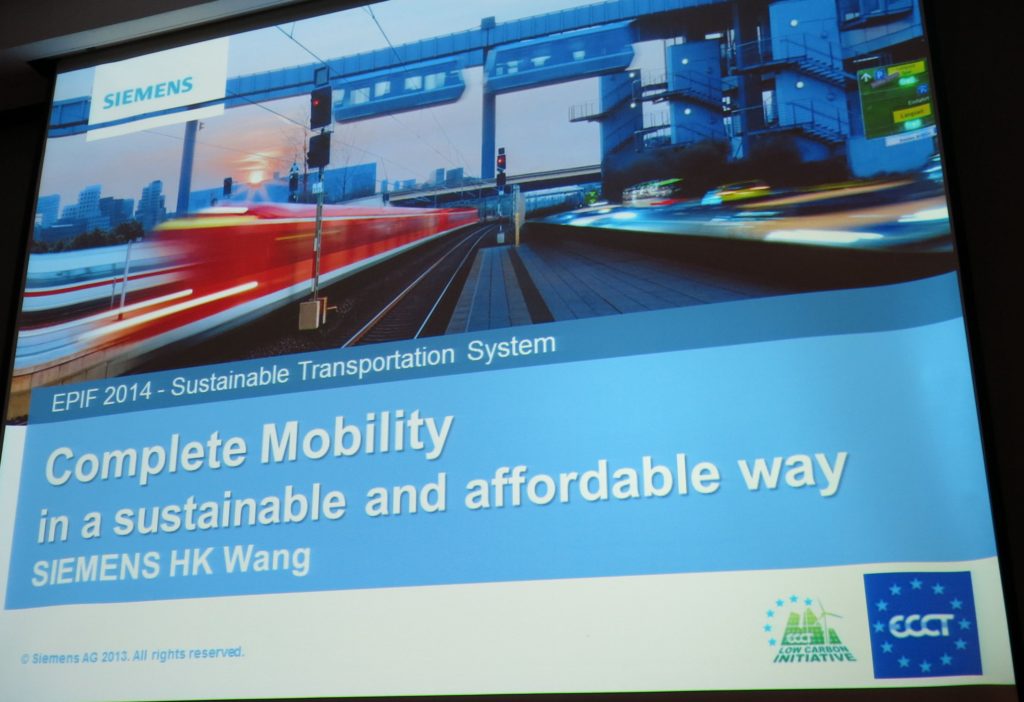
The megatrends urbanization, demographic change, climate change and globalization are posing a tremendous challenge for mobility in the future. More than ever before, the quality of life and competitiveness of regions will depend upon safe and fast public transportation. Wang gave an introduction to Siemens' "Complete mobility" solutions to meet the challenges imposed by the megatrends. His presentation covered his company's efficient mobility and logistics solutions for an integrated traffic system – to move people and goods economically, quickly and safely. It also outlined environmentally-compatible and sustainable mobility solutions that can reduce pollutant emissions and conserve valuable resources.
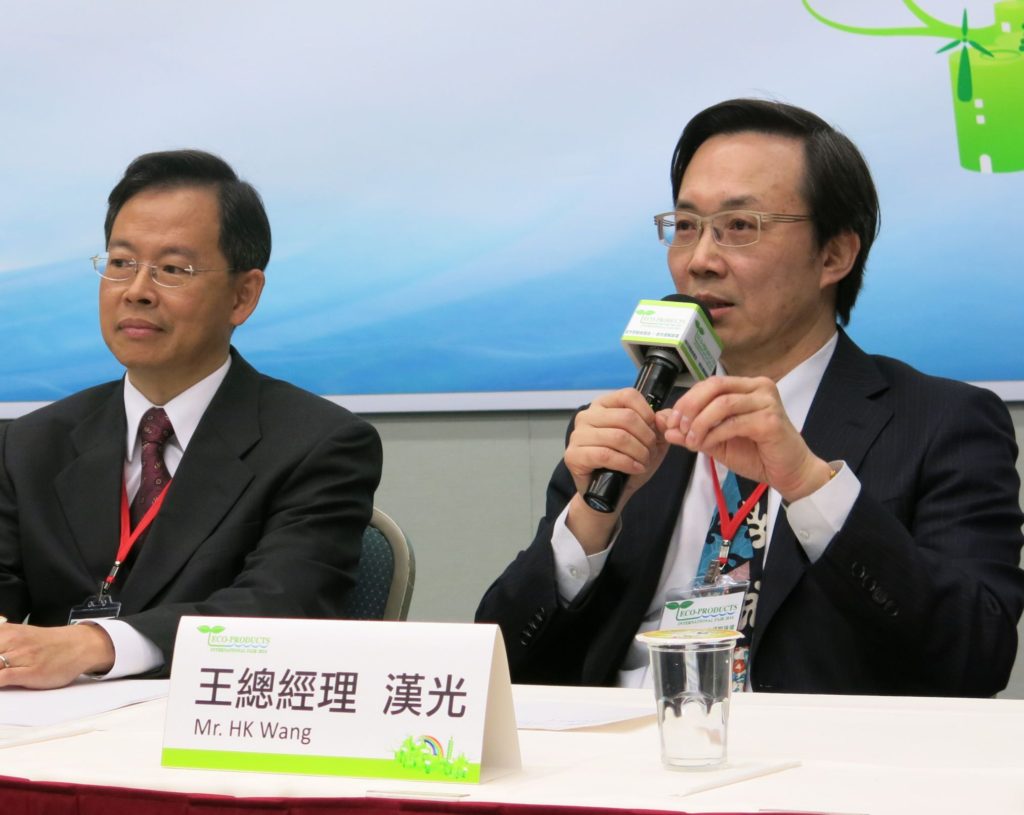
The concentration of CO2 in the atmosphere has reached the highest level ever. 60% of the world's population or about 4.7 billion people will live in cities by 2030. 75% of all energy will be consumed by cities, which will be responsible for 80% of emissions. This is why transportation networks are so important to reduce congestion, pollution and emissions. We need complete mobility solutions that take account of all aspects of travel and communications.
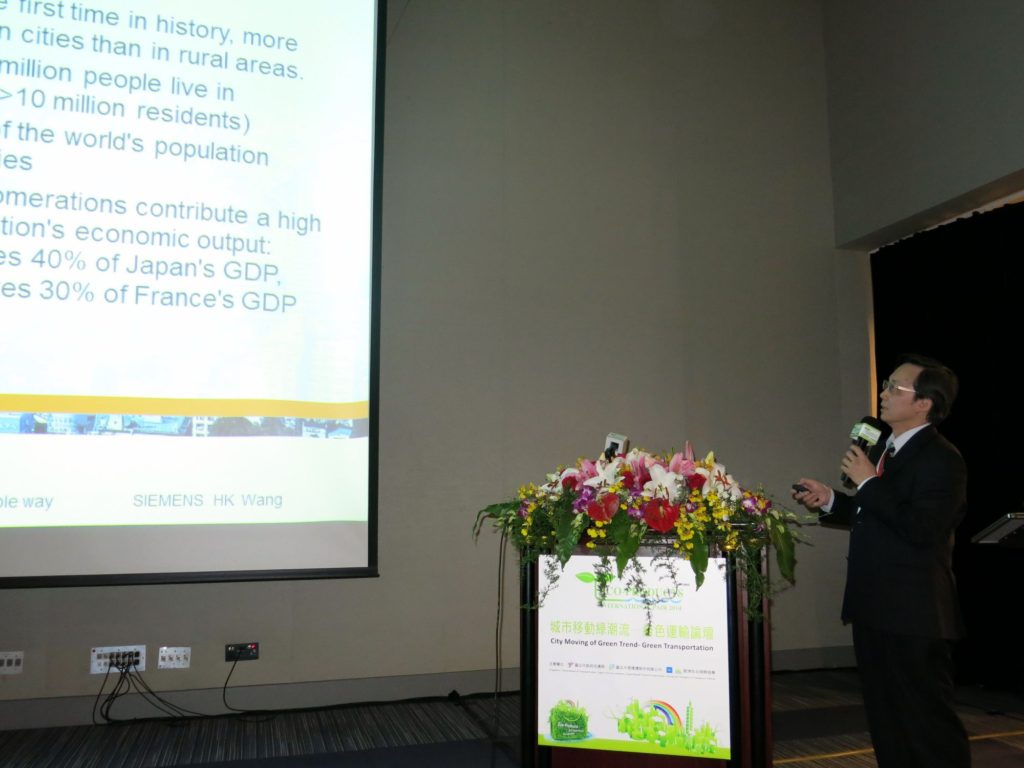
Moreover systems need to work with one another, people and goods must flow smoothly and efficiently. Part of the solution will be flexible and scalable transport units for goods. Private mobility will need more efficient cars which are intelligently linked and increasingly autonomous.
Topic: Smart mobility: Solution to cities' immediate challenges
Speaker: Duarte Morgan, Marketing Manager, Schneider Electric
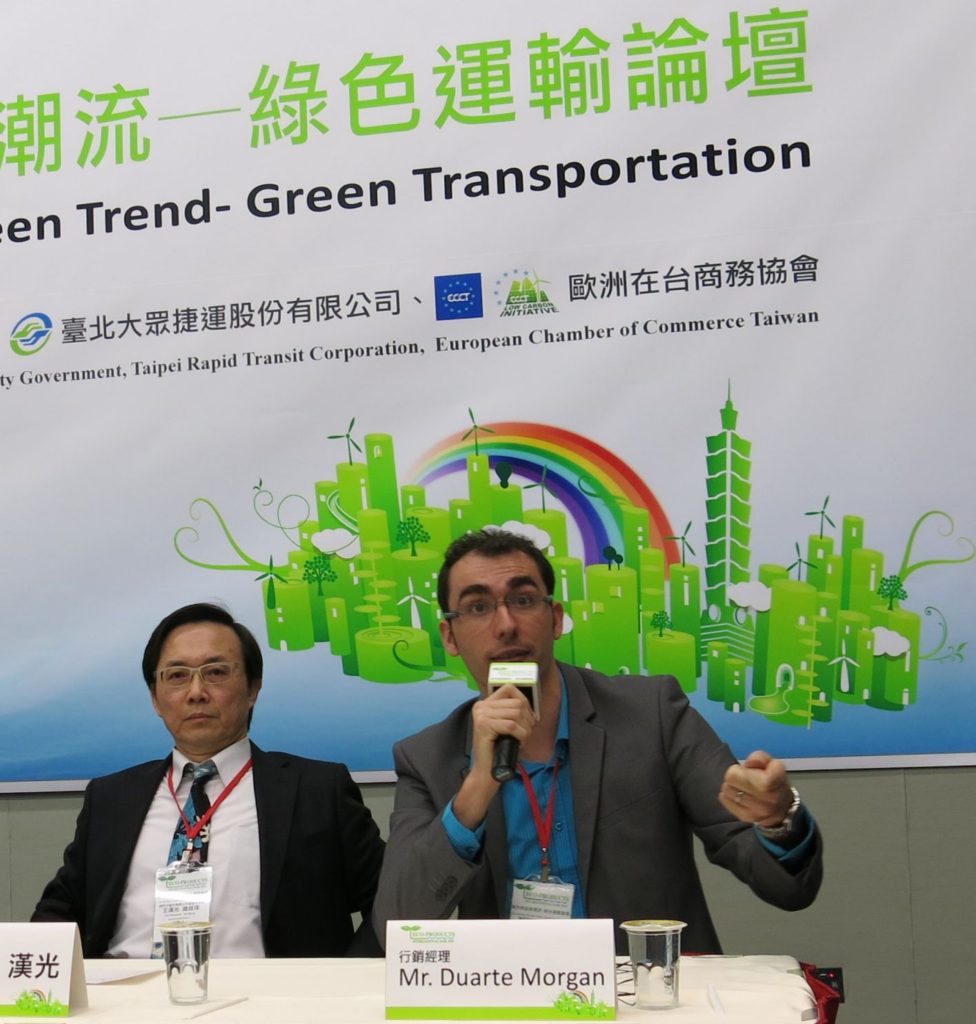
A big challenge we face is the rising demand for electricity and the simultaneous need to reduce emissions. Cities use 75% of global energy and account for 80% of global emissions and urban populations will continue to grow. Other challenges countries the world over are facing include large debt levels and the need to attract talent and investment. It is not easy to become a smart city given the numerous stakeholders to satisfy. For cities to become smarter they need to integrate solutions in the same way that Apple integrated a phone and music player into one device. Drivers waste an average of eight working days a year in traffic and looking for parking. This is a good example of why we need new and smarter solutions for transport. Governments need to work with all stakeholders to become smarter and satisfy social needs at the same time.
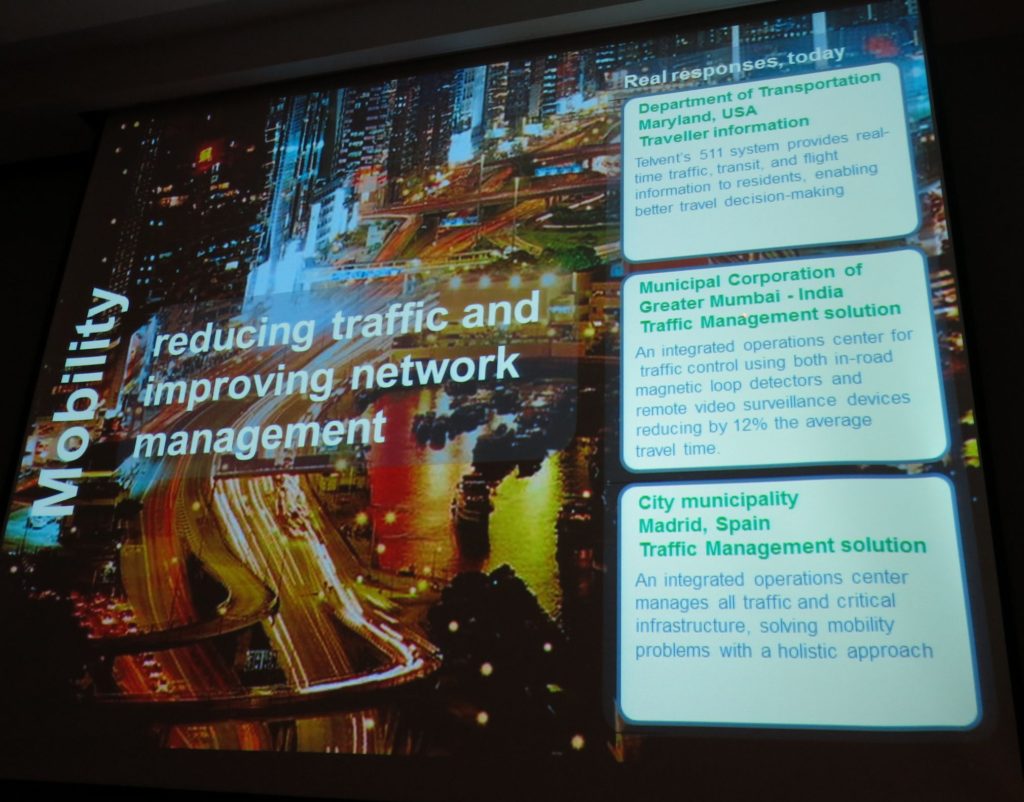
To improve traffic flow requires traffic data gathering and analysis and smarter traffic light control. This is a field that Schneider is engaged in. It is working in several cities to integrate the systems of several operators onto single platforms. In order to realise the mass adoption of electric vehicles (EVs) requires an EV charging infrastructure. This brings with it a number of challenges such as policy, infrastructure (charging stations as well as a robust supply of electricity from the grid so that a large number of vehicles can be recharged simultaneously), ease of use (including safe technical and business model solutions).
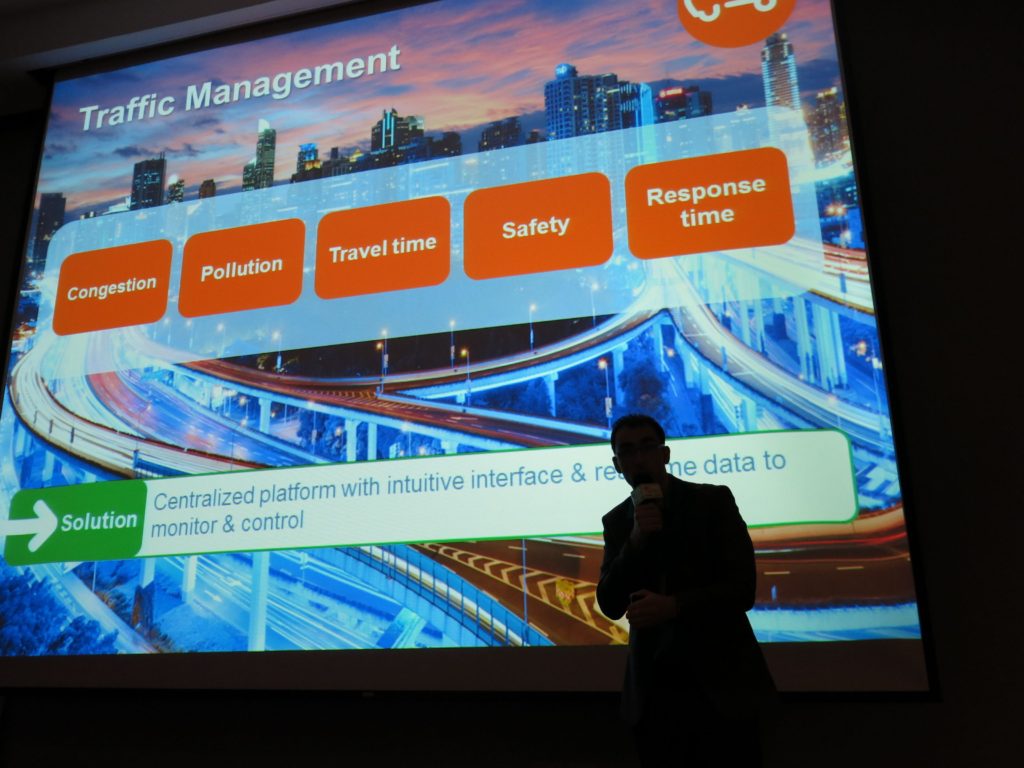
Information and communication needs to be accurate and up-to-date. For example, the driver of an electric car should have real time information available on where the nearest available recharging station is at any given time. It is also not enough to just have a GPS map of the quickest geographical route. If, for example, a large public activity such as a marathon or religious parade is blocking the road, this information needs to be integrated into smart navigation systems.
In an ideal world, the best systems would be purchased and installed immediately but given limited budgets, governments will have to adopt a step by step implementation. For this reason it is vital that governments first agree to an overall vision and master-plan framework which sets the main objectives and allows for the gradual roll-out of systems. For example, limited budgets can be used to start pilot programmes, which can be adapted for optimal effect while in process before mass roll-out.
Saturday, 15 March 2014
Greenwashing forum
Co-organised by the Environmental and Development Foundation and Bureau of Foreign Trade, Taiwan Green Trade Office, MoEA
Moderated by Dr Ning Yu, Senior Advisor, Environment and Development Foundation
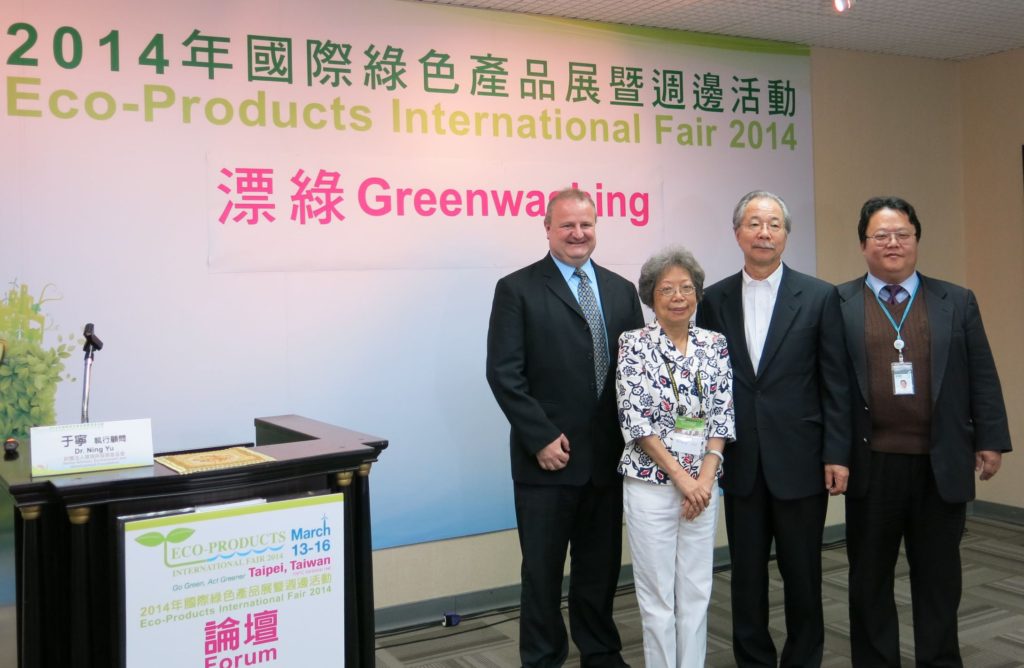
Topic: GPP and greenwashing
Speaker: Professor Hideki Nakahara, Tokyo City University & Chairman, International Green Purchasing Network (GPN)
Professor Nakahara began with an overview of climate change and the need for green procurement. When considering the environmental impact of products, you need to think about whole life cycle. Nakahara gave a number of examples of egregious greenwashing such as oil and airline companies, which use slogans such as "greener way to fly" when there is currently no such thing or cigarettes claiming to be organic. According to Nakahara greenwashing is like termites in a house that have to be cleaned out. According to Greenpeace's definition, greenwashing is used to describe the act of misleading consumers about the environmental impact of products or services.
Nakahara said that there are now over 437 eco-labels in the market. This creates much confusion and the lack of common standards is of course open to misuse. Some countries have introduced preventive measures. For example, Australia and Japan have environmental labelling guidelines. Nakahara gave a rundown of the most common types or "sins" of green washing which range from fluffy language, suggestive pictures to detract from the real subject, best in class claims, irrelevant claims, claims that are not credible to outright lies. Besides the airline claiming to be green cited previously other egregious examples are making claims that cannot be verified, claiming to be "natural", when natural does not necessarily mean not harmful (arsenic, uranium, mercury and formaldehyde are found in nature).
Topic: The status of greenwashing in the RoC
Speaker: Chen Chin-yuan, Project Manager, Environment and Development Foundation
Chen sited examples of greenwashing in Taiwan. A common example is hidden trade off whereby a company makes green claims but ignores major issues. For example paper companies claim to use wood from sustainable forests but the major pollution caused by them is from the production of pulp which consumes energy and causes water pollution. Only focusing on the source of wood is clearly not enough to be green. "All natural" does not mean free of toxins. There are many examples of companies making their own labels which are not verified by third parties. Another greenwashing tactic is the "lesser of two evils" claim, that is that a product is less bad than its rivals, for example "organic cigarettes".
The Environment and Development Foundation did an investigation in 2010 based on three principles: vagueness, irrelevance, no proof and fibbing. Afterwards they implemented the green purchasing alliance and developed local principles on greenwashing to educate consumers and business. Their survey focused on detergents, toy and paper products (863 items in total). 71% of the products had environmental claims, which the EDF then checked. They found that less than half of detergent products have green claims. Of the detergent products, 82% of claims were clear and 99% were relevant but only 43% of green claims were verifiable. The rest were either not verifiable or outright lies. Among the conclusions drawn from the survey is that people have begun to care about green labelling but greenwashing is widespread and this damages confidence. There is a need to educate consumers and urge them to buy products with recognized certified labels. For their part, companies should make sure that their products are truly green and then to get them certified by a reputable third party. The government also needs to do more to educate customers. In this regard the EPA is drafting regulations, the "Environmental Preferable Product Act".
Topic: Greenwashing
Speaker: Bodo Kretzschmar, Chief Operating Officer, TÜV Rheinland
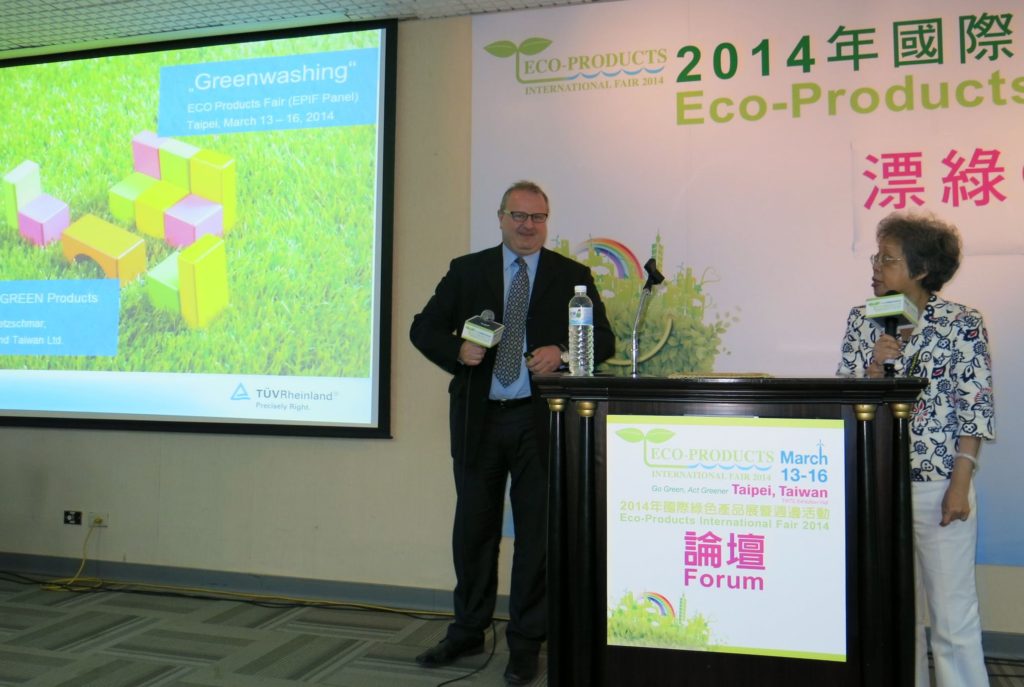
More legislation is being put in place to make environmentally-friendly and power-efficient products mandatory and these products are being produced. Manufacturers have started to realize that the megatrend towards going green can actually be profitable. Still, the general public needs to be educated to enable them to differentiate between ‘Greenwashed Products'- claiming to be (but not actually) ‘green'; from those which are indeed green. Governmental and third party schemes can help to identify real green products.
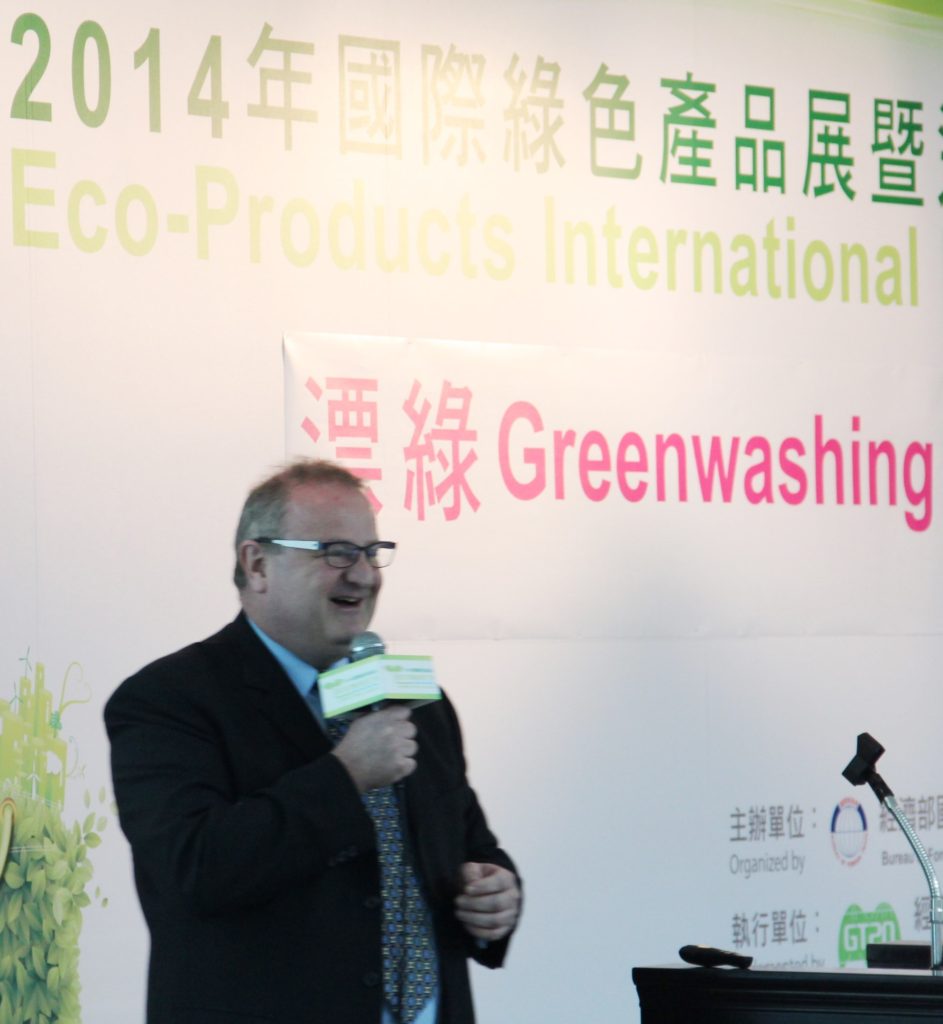
If companies see a marketing advantage and use it to disguise the real impact of their products, then that is greenwashing. Kretzschmar cited the example of bottled water. Referring to an advertisement that promotes the "eco-shape" of a bottle which uses 50% less plastic. "Eco-shape" is a meaningless and misleading term that has nothing to do with the environment while using less plastic is using the greenwashing strategy of "the lesser of two evils". But the very nature of bottled water is not green for three main reasons:
· PET production uses a lot of energy, resulting in large Co2 emissions. According to Kretzschmar, 1.5kgs of CO2 is generated in the production of one plastic bottle, an unnecessary generation of CO2.
· Secondly, bottled water has to be transported. When it is bottled locally, this is not so much of an issue but some consumers like to drink water bottled overseas. Given the massive carbon emissions from air travel, this adds a huge amount of CO2 to the atmosphere.
·The third problem is disposal. Even if some bottles are recycled (around 50% in Taiwan for example), the rest are usually incinerated and of course the recycling process also generates emissions.
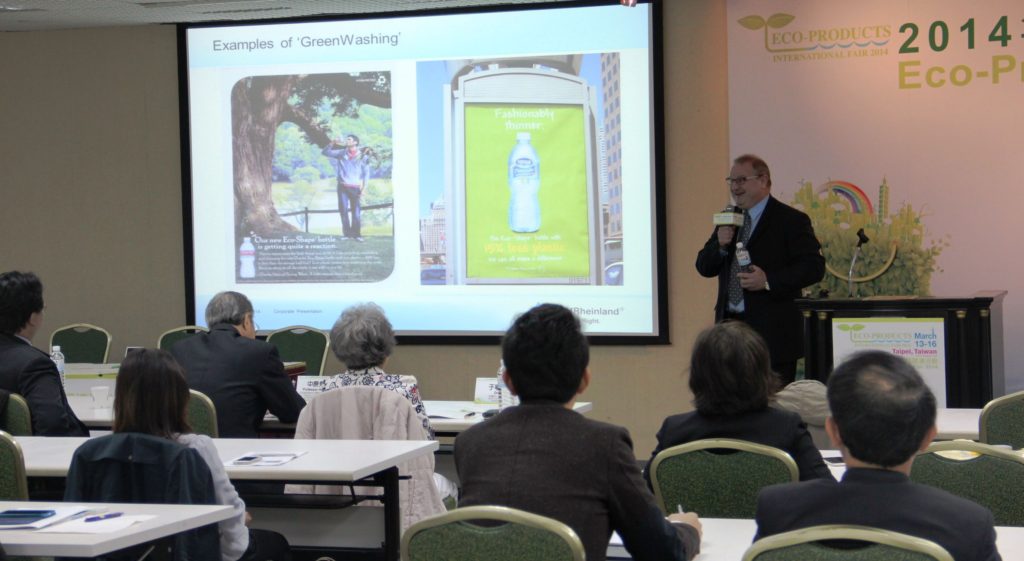
The good news is that governments the world over have identified this as a problem and society is waking up. If society keeps demanding real green products and government put in place the right laws, business will move. There are now more regulations in which outlaw products that are toxic and there are voluntary as well as mandatory labels in some countries. Most consumers now only buy energy efficient Class A fridges now, for example.
Kretzschmar concluded by introducing TÜV Rheinland's green product mark, which is based on the highest EU and international standards.
The mark is voluntary and looks at four dimensions:
- The responsible use of chemicals
- Waste management – whether the product is reused and if it can be recycled
- Energy and water consumption and efficiency
- Carbon footprint - Society needs to be educated on what a carbon footprint is, how it is measured and how valuable it is. For example, a local computer company claims that its production of notebook is carbon neutral because the production is efficient and it buys offsets for the rest. However, it doesn't address the power efficiency during the life of the compute or the level of recycling. Moreover, its claims of just 150kgs of emissions is a little suspect. For this reason it is always best to use a third party to verify claims as these are much more likely to be believed than self-certified product claims.
Drive into the future forum – New energy vehicles
Arranged by the ECCT's LCI
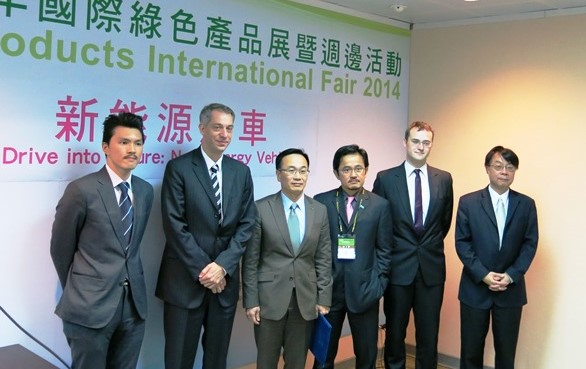
Topic: Lightweight materials for vehicles
Speaker: Englong Goh, Managing Director, BASF Taiwan
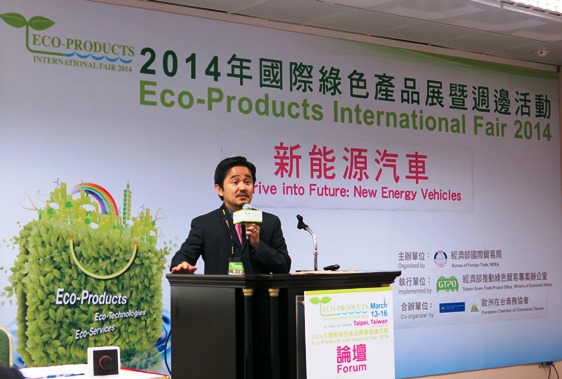
Weight is a major factor in fuel consumption of vehicles and BASF is involved in materials for lightweight vehicles. 85% of fuel consumption is determined by weight during use in the life of the car while manufacturing and recycling account for just a small part. It is possible to reduce the weight of a vehicle by up to 100 kilograms (kgs) by using carbon fibre materials.
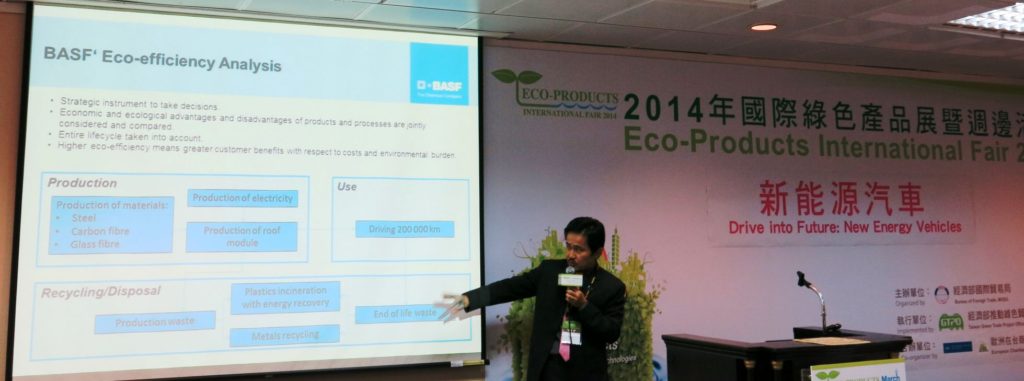
Given that an average passenger car weights about 1.2-1.3 tonnes, reducing the weight by 100 kgs is significant. In addition, further weight reduction is possible by replacing other vehicle parts with carbon fibre composites. BASF has a comprehensive eco-efficiency analysis method which covers the entire "cradle to grave" impact on the environment.
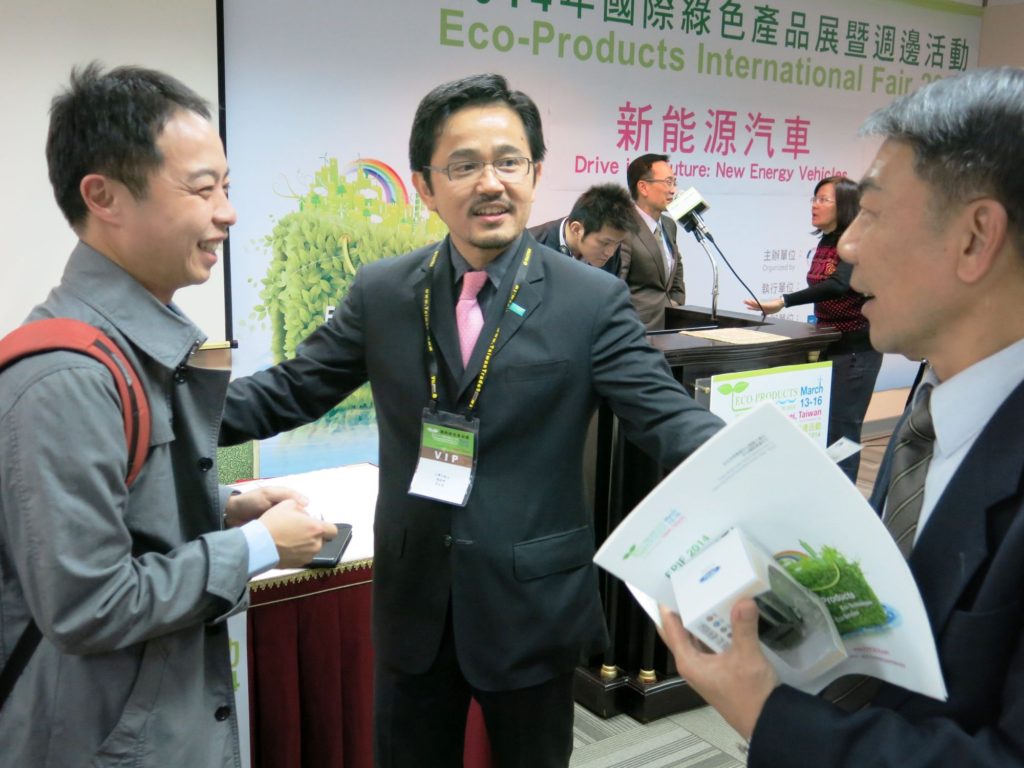
Topic: EV charging infrastructure: Introduction to intelligent charging solutions
Speaker: Steve Hsu, Business Development Manager, ABB
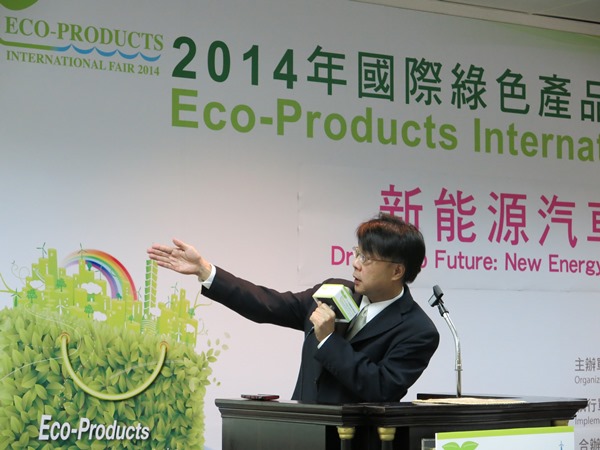
Greenhouse gas emissions from transport are projected to rise 70% by 2050. Electric vehicles can help to drive this down. ABB has solutions for the whole EV charging value chain from stations, chargers, energy storage, substations, grid automation and integration with renewables. Hsu introduced ABB's EV charging solutions, which combine the company's key strengths in power electronics, software, service and power distribution to meet the needs of both drivers and service providers.
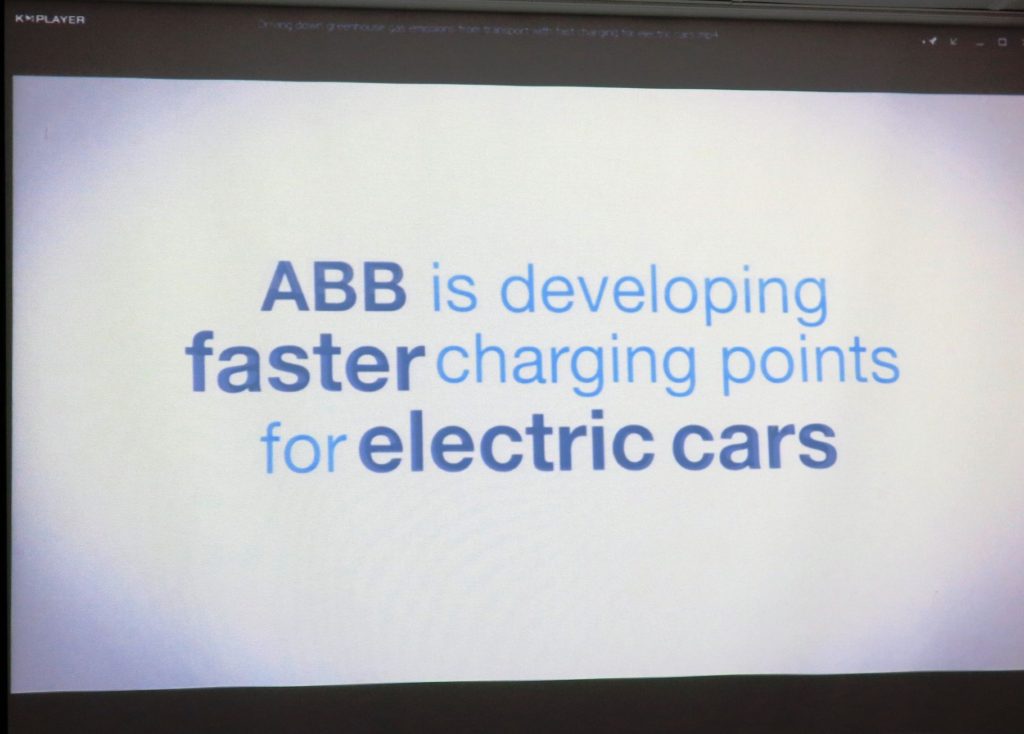
ABB is a leader in charging infrastructure for all EV charging standards. ABB chargers are internet-connected to ensure the highest uptime. Internet-based charging enables fast global service and pro-active maintenance. In addition, the chargers easily connect to any service or payment application to increase added value.
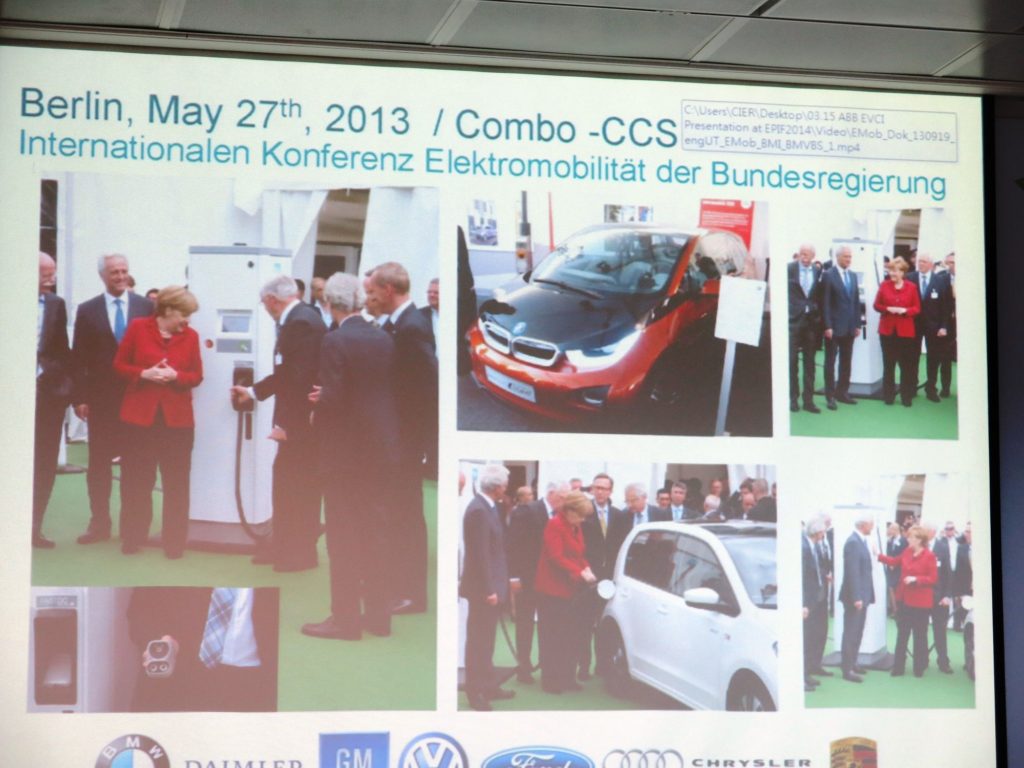
ABB fast chargers need just 15-30 minutes to charge an electric vehicle. Vehicles can be charged to 80% in 20 minutes. The company has already installed 165 fast charges in Estonia, catering to a full range of vehicles, and has similar projects in Denmark and the United States. According to Hsu, international standards will soon be finalized for charging and Taiwan should follow IEC standards.
Topic: Bosch solutions for electric vehicles
Speaker: Bernd Barkey, Managing Director, Bosch Taiwan
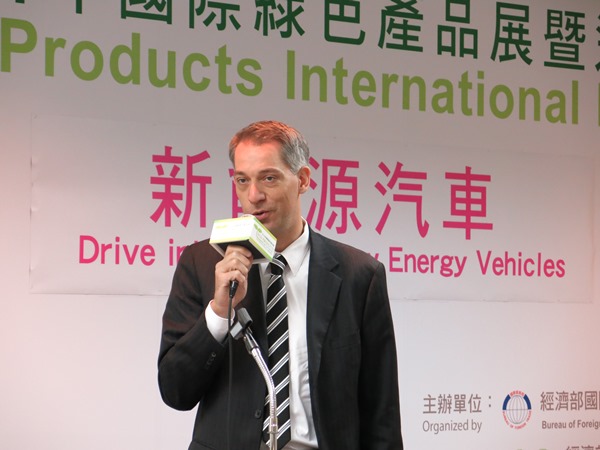
The future of mobility is electric. Bosch spends 400 million euros each year and employs more than 1,100 associates in this area, covering the entire electrical powertrain portfolio, such as lithium-ion battery systems, battery management, power electronics, etc. Bosch offers electrical powertrains ranging from Fiat's 500e to the plug-in hybrid system of the Porsche Panamera.
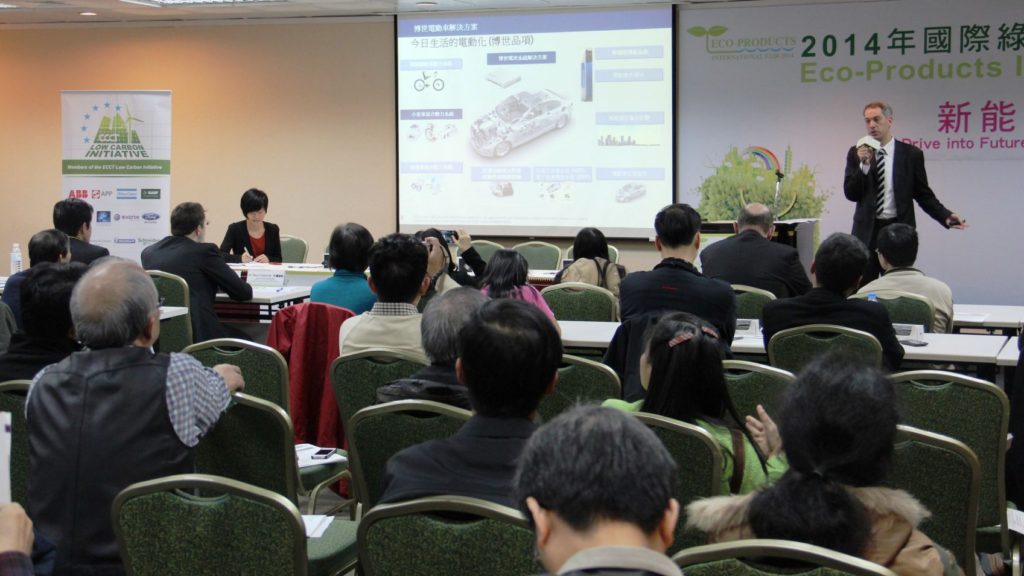
The question is not if the transition to electromobility is coming but rather by when. Progress in the development of batteries is considered the most important driver of the market success of electrical powertrains. But of similar importance is a holistic understanding of the whole electric vehicle (EV) system and the related business eco-system. Government plays an important role in setting the right policies and incentives to pave the way to success. In Singapore, Bosch works very closely with the government, having established an EV ecosystem which has run successfully since 2011.
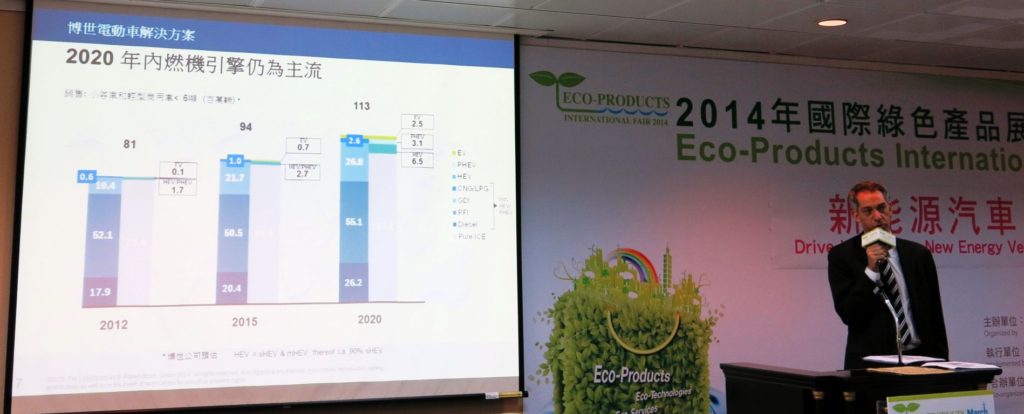
Transport is responsible for almost a quarter of CO2 emissions. Electric vehicles should only be considered truly "zero emission" vehicles if the production of electricity they run on is from renewables. In the meantime, there are now lots of ways to save up to 30% on traditional motors before the eventual switch to electric vehicles. The key to progress is much better batteries. Besides having good batteries, pure electric vehicles need to be light and small to increase range. Bosch expects the total vehicle market to reach 130 million units by 2020 and only 2.5 million will pure electric. For the large-scale adoption of electric vehicles, we need to consider not just the batteries but also EV infrastructure. For this there needs to be cooperation between government and industry.
Topic: Power of choice
Speaker: Thomas Fann, President, Ford Lio Ho

There is no single car or product solution to reducing emissions. Multiple solutions are needed and Ford is working on all technologies simultaneously to reach the goal. It is also working with a number of partners such as material suppliers to reduce emissions.
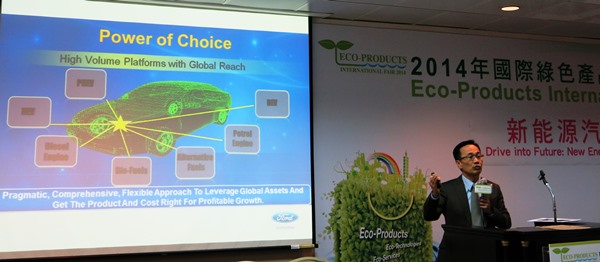
The pure electric age will take a number of years. Ford's "well to wheel study" includes 140 pathways studying efficiency and emissions, taking into account the feedstock fuel source and vehicle technology. Technology is developing fast and each generation is better than the one before. It is also important to look at the entire global supply chain in evaluating the true environmental impact of a vehicle.
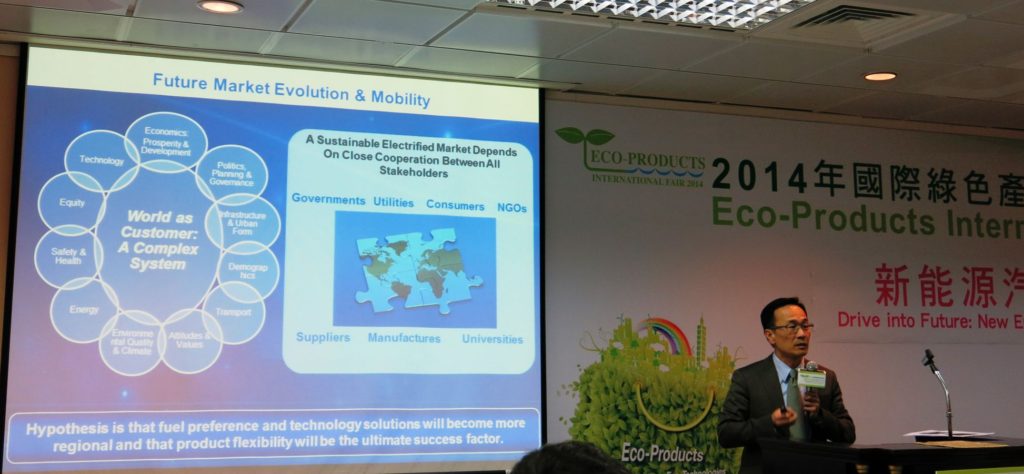
For example, an EV in California may be great for California but it could indirectly bring dirty rain to Taiwan if the vehicle produced in an environment where the source of electricity is dirty. Fann concluded that a sustainable electrified market depends on close cooperation between all stakeholders - government industry and consumers.
Topic: SARTRE and self-driving
Speaker: Gilbert Wu, Field and Training Manager, Volvo Car Taiwan
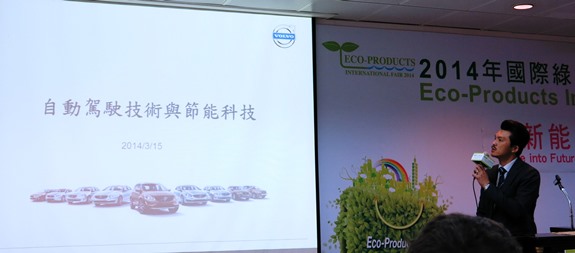
Wu introduced Volvo's innovations to reduce emissions by 33% using a combination of technologies, such as "start stop" technology to save fuel at stop lights automatically. Wu also introduced "Safe Road Trains for the Environment" or "SARTRE", an autonomous driving system. Wu played a video demonstrating the system used in a real test on a real highway which, for the first time, a convoy of vehicles, all with SARTRE systems installed, allowed vehicles to drive themselves on a highway safely, even in windy conditions.
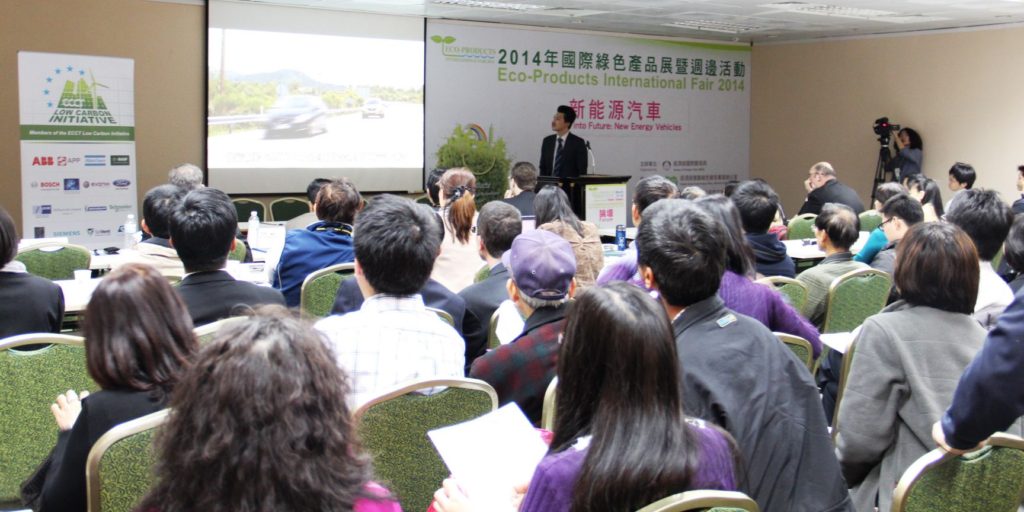
The test demonstrated how autonomous driving will not only eliminate human error to reduce accidents but also reduce drag (and therefore fuel consumption and emissions) by driving in convoy. Volvo is collaborating with six other partners. At the moment the driver still has to supervise the system. Before autonomous driving can be implemented on a large scale, legislation will need to be put in place to specify liability and insurance issues in the event of accidents.
Panel discussion
Moderated by Raoul Kubitschek, LCI Director
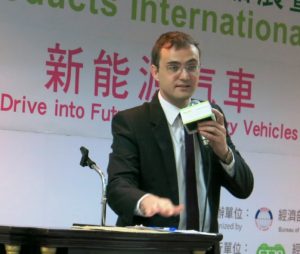
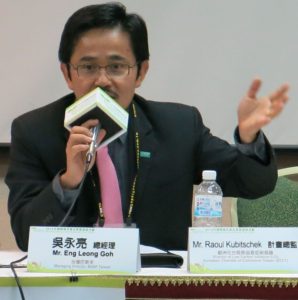
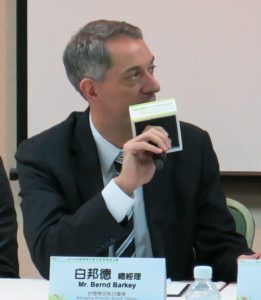
On a question as to how much more the weight of vehicles can be reduced, Englong Goh said that if carbon fibre materials like the ones produced by his company are employed to replace metal in car chassis and other interior parts, weight can be reduced by 20-30%.
On a question as to how the government can support the EV market, Bernd Barkey said that regulation on chargers is needed first. He also noted that public funds are spread too thin among local governments and a better solution would be to pool resources so that large and meaningful projects can be carried out. It is also important that Taiwan follows IEC standards, not just for plugs but also international standards for batteries.
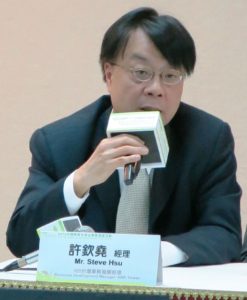
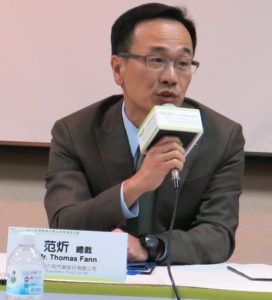
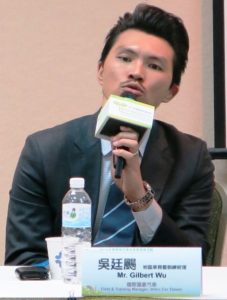
The most important markets for electric vehicles are the United States, Germany and China. If EVs are successful on a large scale in these markets, then the world will follow. Besides the question of technology, prices need to come down before the market can take off. In addition, stakeholders need to work out logistics for the grid – if too many cars are plugged in to recharge at the same time, systems will crash. Therefore a successful EV roll-out needs careful planning and implementation.
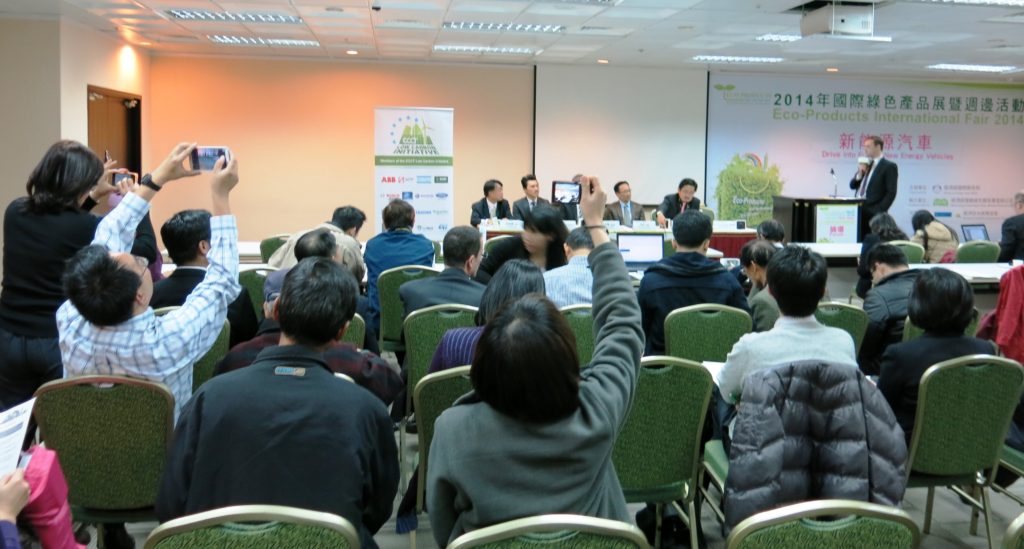
In countries like Taiwan, the problem of limited space for charging stations also needs to be resolved. To reduce the number of vehicles, car sharing business models could be tried. Panelists concluded that Taiwan is the perfect test bed for electric vehicles given its small size, expertise in electronics and the large potential market in mainland China. However, there is still work to do to put in place a good regulatory system and coordinate funds.
Sunday, 16 March
The A Team: Energy Efficiency Saves $ forum
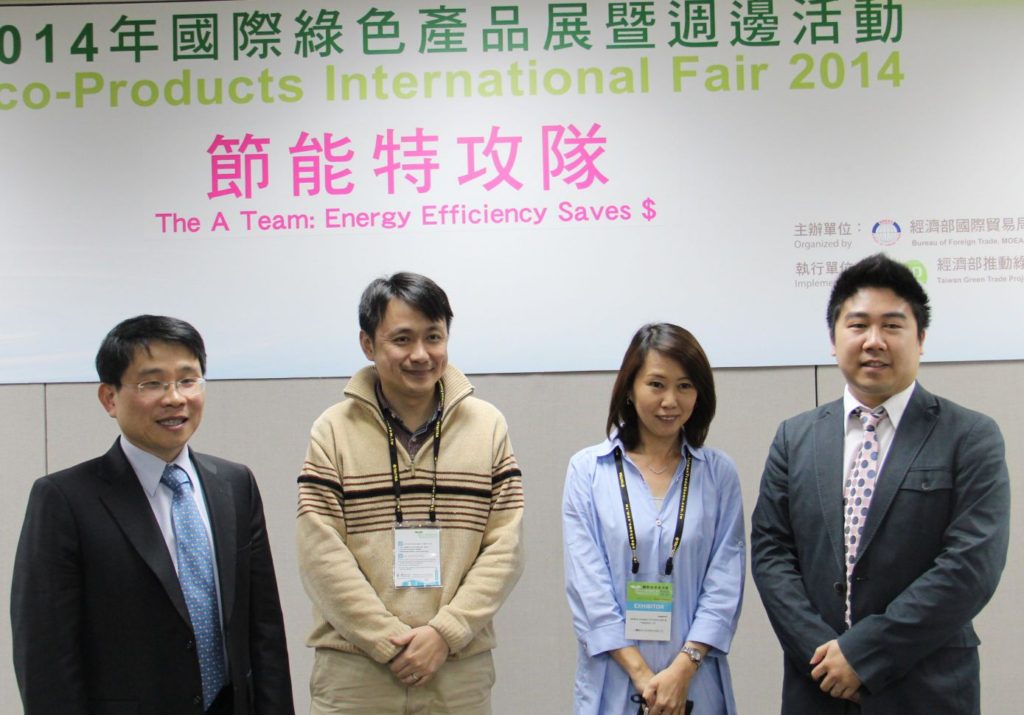
Topic: Energy efficiency
Speaker: Kong Po-chen, Senior Manager, Schneider Electric
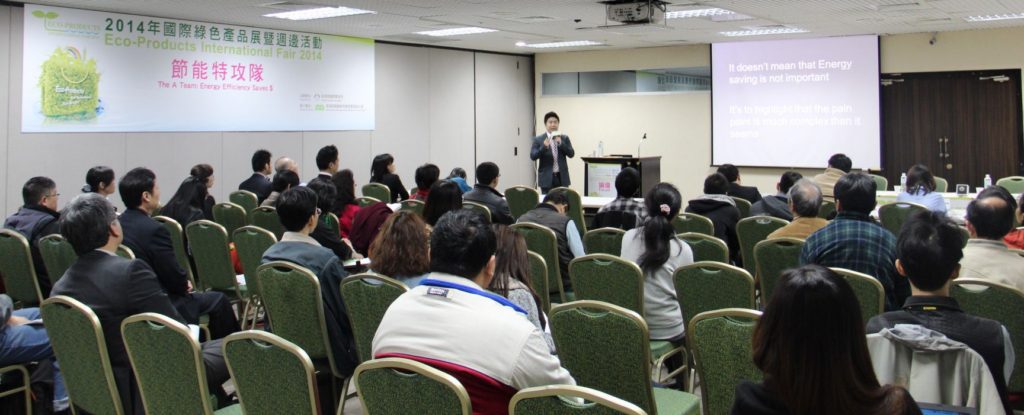
Each year, drivers in cities around the world waste billions of gallons of fuel sitting in traffic. Cities need to become smarter to improve resident mobility by providing better information and improved interoperability as well as integration of electric vehicles.
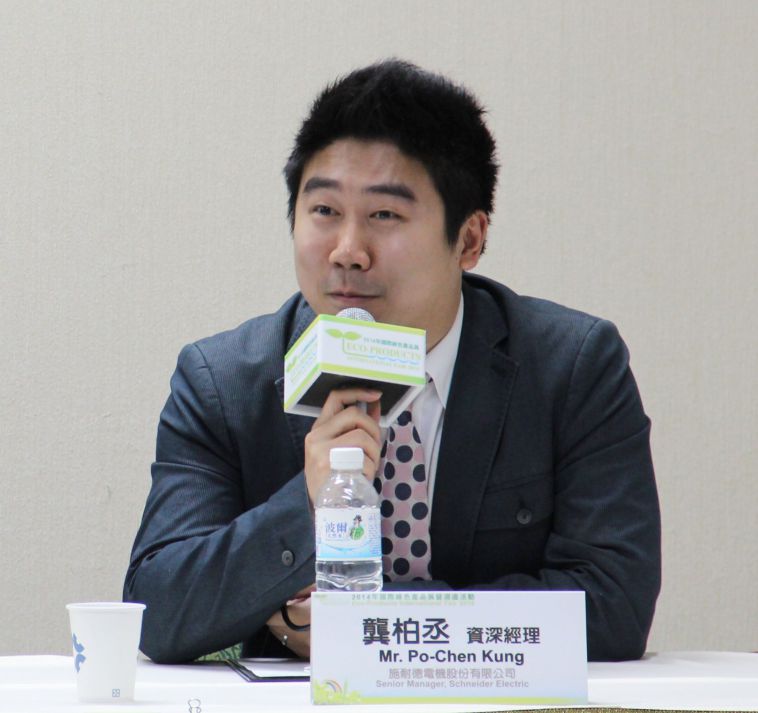
Solutions exist and offer better management of multi-modal transit networks, fewer disruptions to service and help to reduce traffic congestion, increase public transit use and lower emissions. To retain or regain their attractiveness and competitiveness, manage their growth in a controlled way and provide better public services to citizens, cities need to become smarter, more efficient, more sustainable, and more livable. Kong's presentation presented cities' transportation challenges and offered successful solution stories from three continents.
